SOLiD NH700L HPRD (High Power Remote Drive Unit) User Manual MB DAS
SOLiD, Inc. HPRD (High Power Remote Drive Unit) MB DAS
SOLiD >
installation Manual
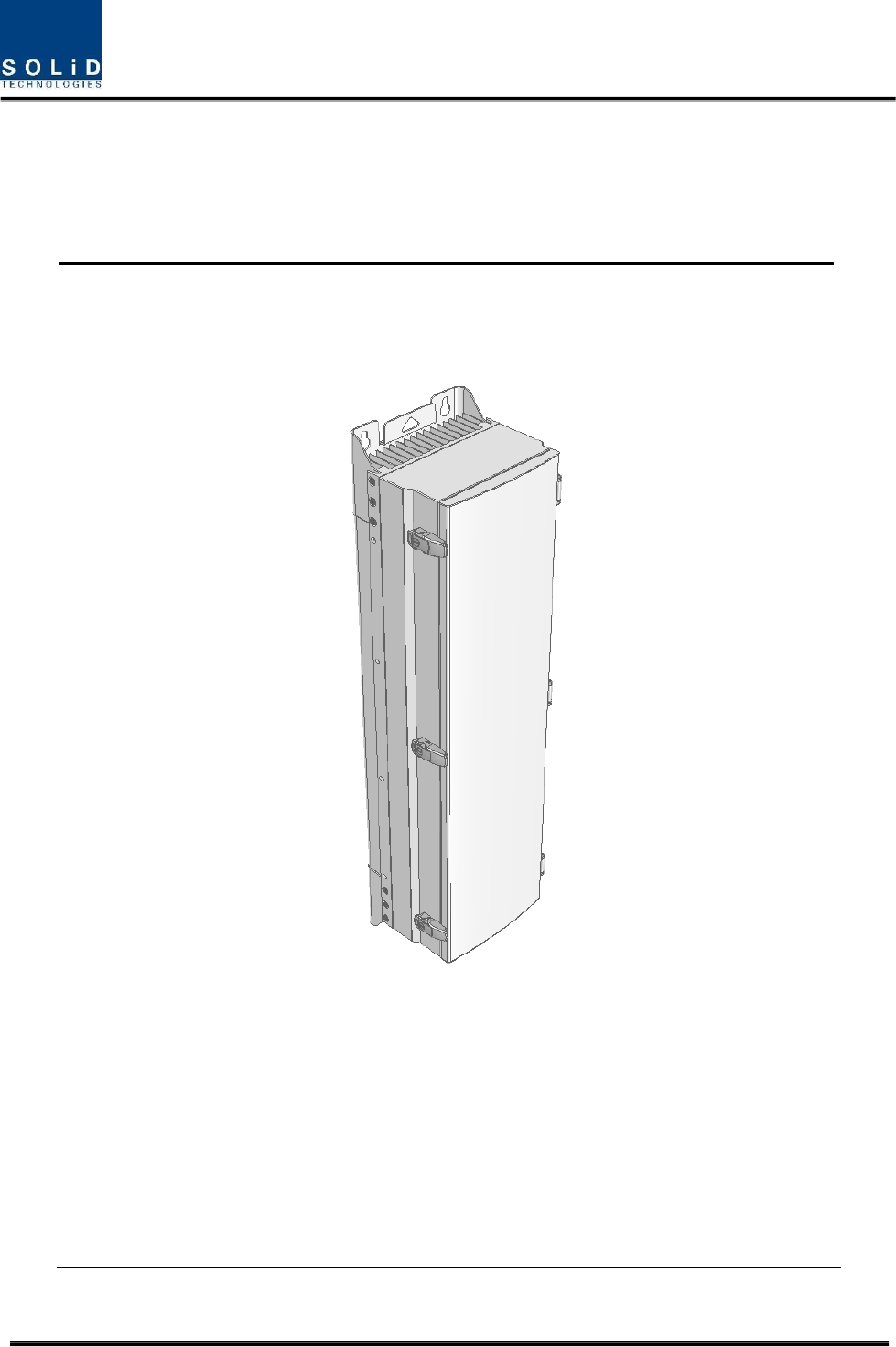
Confidential & Proprietary 1/43
ALLIANCE_N20(Remote Unit)
User Manual
Document Reference:
Version: V1.0
Document Status: Release 1
Issue Date: July. 16, 2014
Author: Hwan sun Lee
Department: R&D Division Team 3
Authorizing Manager: Young shin Yeo

Confidential & Proprietary 2/43
REVISION HISTORY
Version
Issue Date
No. of
Pages
Initials
Details of Revision Changes
V 1.0
Aug. 20, 2014
Original
Technical Support
SOLiD serial numbers must be available to authorize technical support and/or to establish a return
authorization for defective units. The serial numbers are located on the back of the unit, as well as on
the box in which they were delivered. Additional support information may be obtained by accessing the
SOLiD Tehcnology, Inc. website at www.solid.co.kr or send email at sjkim@st.co.kr
This manual is produced by Global Business Division Business Team 1. Printed in Korea.

Confidential & Proprietary 3/43
Contents
Section1 Safety & Certification Notice ....................................................................... 6
Section2 System Overview ...................................................................................... 10
2.1 Purpose ......................................................................................................... 11
2.2 System overview ............................................................................................ 12
Section3 System configuration and Functions ........................................................... 14
3.1 HROU (High power Remote Optic Unit) ............................................................ 14
3.1.1 Specifications of HROU ............................................................................. 15
3.1.2 Block Diagram of HROU ............................................................................ 16
3.1.2.1 HMRU block diagram ................................................................................ 16
3.1.2.2 HROU inner look ...................................................................................... 17
3.1.2.3 HROU part list .......................................................................................... 18
3.1.3 Function by unit ....................................................................................... 19
3.1.3.1 High Remote Drive Unit (HRDU) ................................................................. 19
3.1.3.2 Remote Power Supply Unit ( RPSU) ............................................................ 21
3.1.3.3 Remote Optic(R OPTIC) ............................................................................. 22
3.1.3.4 Remote Central Processor Unit (RCPU) ....................................................... 22
3.1.4 Bottom of HROU ...................................................................................... 23
3.1.4.1 Functions ................................................................................................. 23
Section4 System Installation ................................................................................... 25
4.1 HROU Installation ........................................................................................... 25
4.1.1 Tools ............................................................................................................. 26
4.1.2 HROU Enclosure installation ............................................................................ 26
4.1.3 HROU Wall Mount Installation ......................................................................... 28
4.1.4 HROU components ......................................................................................... 29
4.1.5 HROU Power Cabling ...................................................................................... 31
4.1.6 HROU Ground cabling ..................................................................................... 33
4.1.9 Mounting of HRDU ......................................................................................... 40

Confidential & Proprietary 4/43
Contents of Figure
Figure 1. Basic system topology ........................................................................ 12
Figure 2. Expansion system topology ................................................................. 13
Figure 3. HROU outer Look ............................................................................... 15
Figure 4. HMRU Block diagram.......................................................................... 16
Figure 5. Inside of Remote Unit ...................................................................... 17
Figure 6. HRDU Outer Look ............................................................................... 19
Figure 7. AC-DC RPSU Outer Look ...................................................................... 21
Figure 8. DC-DC RPSU Outer Look ...................................................................... 21
Figure 9. R OPTIC Outer Look ............................................................................ 22
Figure 10. RCPU Outer Look.............................................................................. 23
Figure 11. The Bottom Look of HROU ................................................................ 23
Figure 12. How to install ROU ........................................................................... 27
Figure 13. Dimension used to install HROU on the WALL ...................................... 28
Figure 14. Procedures of installation .................................................................. 29
Figure 15. Location of Ground Terminal ............................................................. 33
Figure 16. Information of Terminal .................................................................... 34
Figure 17. How to install Ground Terminal .......................................................... 35
Figure 18. Location of Optical Connector ............................................................ 36
Figure 19. Information of Optical Connector ....................................................... 36
Figure 20. How to install Optical Cabling ............................................................ 37
Figure 21. Location of ALM IN/OUT Connector ................................................... 38
Figure 22. Information of ALM IN/OUT Connector ............................................... 38
Figure 23. How to install ALM IN/OUT Cabling .................................................... 39

Confidential & Proprietary 6/43
Section1
Safety & Certification Notice

Confidential & Proprietary 7/43
“Only qualified personnel should handle the DAS equipment. Any person involved in
installation or service of the DAS should understand and follow these safety guidelines.”
- Obey all general and regional installation and safety regulations relating to work on high voltage
installations, as well as regulations covering correct use of tools and personal protective equipment.
- The power supply unit in repeaters contains dangerous voltage level, which can cause electric shock.
Switch the mains off prior to any work in such a repeater. Any local regulations are to be followed
when servicing repeaters.
- When working with units outdoors, make sure to securely fasten the door or cover in an open position
to prevent the door from slamming shut in windy conditions..
- Use this unit only for the purpose specified by the manufacturer. Do not carry out any modifications or
fit any spare parts which are not sold or recommended by the manufacturer. This could cause fires,
electric shock or other injuries.
- Any DAS system or Fiber BDA will generate radio (RF) signals and continuously emit RF energy. Avoid
prolonged exposure to the antennas. SOLiD recommends maintaining a 500 cm minimum clearance
from the antenna while the system is operating.
- Antennas must be installed in accordance with FCC 27.50 and SRSP 518. With 17dBi gain antennas
the height of the antenna above average terrain (HAAT) must not exceed 730m. For different gain
antennas refer to the relevant rules and the local licensing authorities
- Do not operate this unit on or close to flammable materials, as the unit may reach high temperatures
due to power dissipation.
- Do not use any solvents, chemicals, or cleaning solutions containing alcohol, ammonia, or abrasives on
the DAS equipment. Alcohol may be used to clean fiber optic cabling ends and connectors.
- To prevent electrical shock, switch the main power supply off prior to working with the DAS System or
Fiber BDA. Never install or use electrical equipment in a wet location or during a lightning storm.
- Do not look into the ends of any optical fiber or directly into the optical transceiver of any digital unit.
Use an optical spectrum analyzer to verify active fibers. Place a protective cap over any radiating
transceiver or optical fiber connector to avoid the potential of radiation exposure.
- Allow sufficient fiber length to permit routing without severe bends.
- For pluggable equipment, make sure to install the socket outlet near the equipment so that it is easily
accessible.
- A readily accessible disconnect device shall be incorporated external to the equipment.
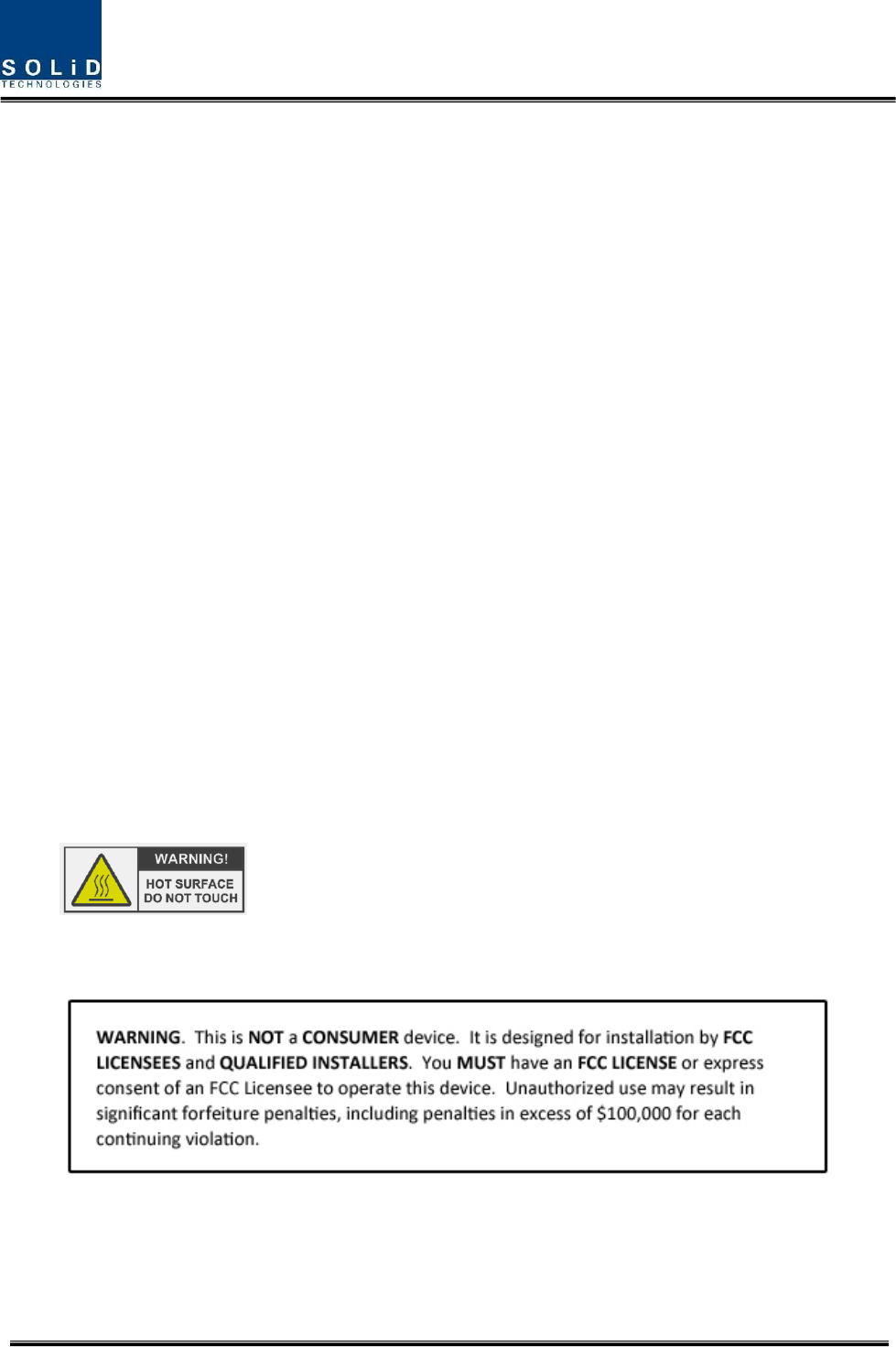
Confidential & Proprietary 8/43
- This power of this system shall be supplied through wiring installed in a normal building.
If powered directly from the mains distribution system, it shall be used additional protection, such as
overvoltage protection device
- Only 50 ohm rated antennas, cables and passive equipment shall be used with this remote. Any
equipment attached to this device not meeting this standard may cause degradation and unwanted
signals in the bi-directional system. All components connected to this device must operate in the
frequency range of this device.
- Only 50 ohm rated antennas, cables and passive components operating from 150 - 3 GHz shall be used
with this device.
- The head end unit must always be connected to the Base Station using a direct cabled connection.
This system has not been approved for use with a wireless connection via server antenna to the base
station.
- Access can only be gained by SERVICE PERSONS or by USERS who have been instructed about the
reasons for the restrictions applied to the location and about any precautions that shall be taken; and
- Access is through the use of a TOOL or lock and key, or other means of security, and is on trolled by the
authority responsible for the location.
- Notice! Be careful not to touch the Heat-sink part due to high temperature.
- Signal booster warning label message should include

Confidential & Proprietary 9/43
- Certification
FCC: This equipment complies with the applicable sections of Title 47 CFR Parts 15,22,24,27 and
90(Class B)
UL/CUL: This equipment complies with UL and CUL 1950-1 Standard for safety for information
technology equipment,including electrical business equipment
FDA/CDRH: This equipment uses a Class 1 LASER according to FDA/CDRH Rules.This product
conforms to all applicable standards of 21 CFR Chapter 1, Subchaper J, Part 1040

Confidential & Proprietary 10/43
Section2
System Overview
2.1 Purpose
2.2 Systemoverview

Confidential & Proprietary 11/43
2.1 Purpose
Alliance_N20 is a coverage system for in-building services delivering voice and data in high quality and
for seamlessly.
As a distributed antenna system, it provides analog and digital phone systems that are served in multiple
bands through one antenna.
The system covers general public institutions and private facilities.
Shopping malls
Hotels
Campus areas
Airports
Clinics
Subways
Multi-use stadiums, convention centers, etc.
The system helps improve in-building radio environments in poor condition and make better poor RSSI
and Ec/Io. By providing communication services at every corner of buildings, the system enables users to
make a call at any site of buildings.
The system uses both analog (AMPS) and digital (TDMA, CDMA and WCDMA) methods.
The SMDR-NH124 system supports communication standards and public interface protocols in
worldwide use.
Frequencies: VHF,UHF, 700MHz , 700MHz_MIMO , 850MHz , 1900MHz , 2100MHz ,
2100MHz_MIMO etc.
Voice protocols: AMPS,TDMA, CDMA,GSM,IDEN, etc.
Data protocols: EDGE,GPRS,WCDMA,CDMA2000,Paging, LTE etc.
Alliance_N20 is in modular structure per frequency. To provide desired frequency in a building, all you
need to do is to insert a corresponding frequency module into each unit. As it delivers multiple signals
with one optical cable, the system, in one-body type, does not require additional facilities whenever
new frequency is added.
The system is featured with the following:
Flexibiltiy & Scalabiltiy
Support fiber-optic ports up to 39
Clustering multiple-buildings (campus) as one coverage
Modular structures
Modular frequency upgrade
Plug-in type module
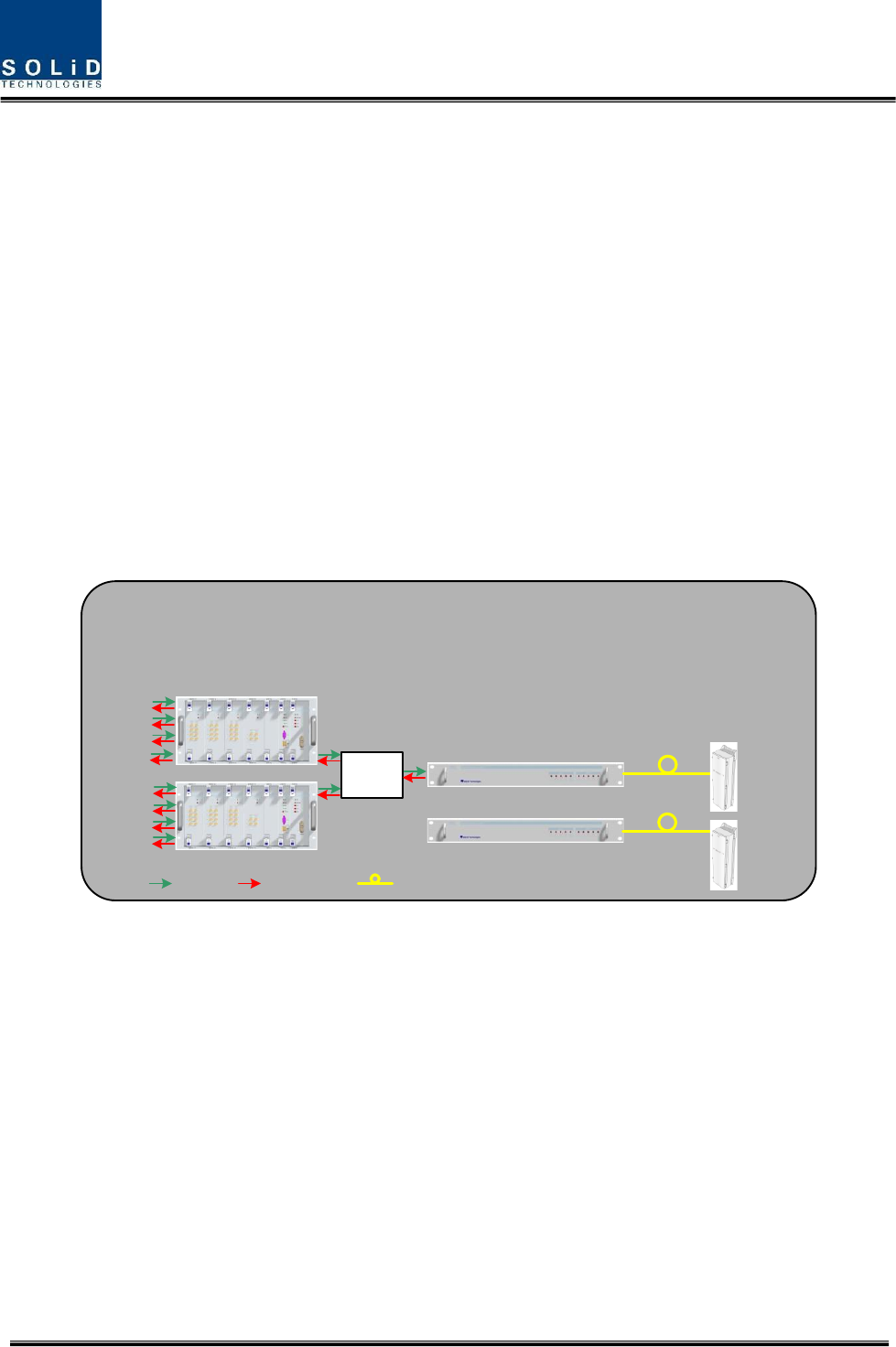
Confidential & Proprietary 12/43
Multi-Band, Multi Operator
Signals with a plurality of service provider transmit simultaneously
Support multi-operator in a band
Low OPEX / CAPEX
Compact design
Upgradable design
Easy installation and maintenance
Web Based SNMP or GSM Modem or UDP support (Optional)
2.2 System overview
The Alliance_N20 is composed of devices given below.
Basically, the system consists of BIU (BTS Interfcace Unit), ODU (Optic distribution Unit) and NHROU
(Remote Optic Unit). For addition of more ROUs, it has OEU (Optic Expansion Unit).
BIU
(Master)
BIU
(Slave)
2Way
Divider
850C
700L_S,M
1900P
2100A
2100A_M
.
.
.ROU#1
ROU#32
.
.
.
.
.
.
ODU#1
ODU#4
RF Tx RF Rx
Max 5dBo
Max 5dBo
Optic cable
Basic Configuration (DOU : OM4)
BIU(Max 2 Units)
ODU(Max 4 Units)
ROU(Max 32 Units)
800P,900I
700P
2500T
Figure 1. Basic system topology
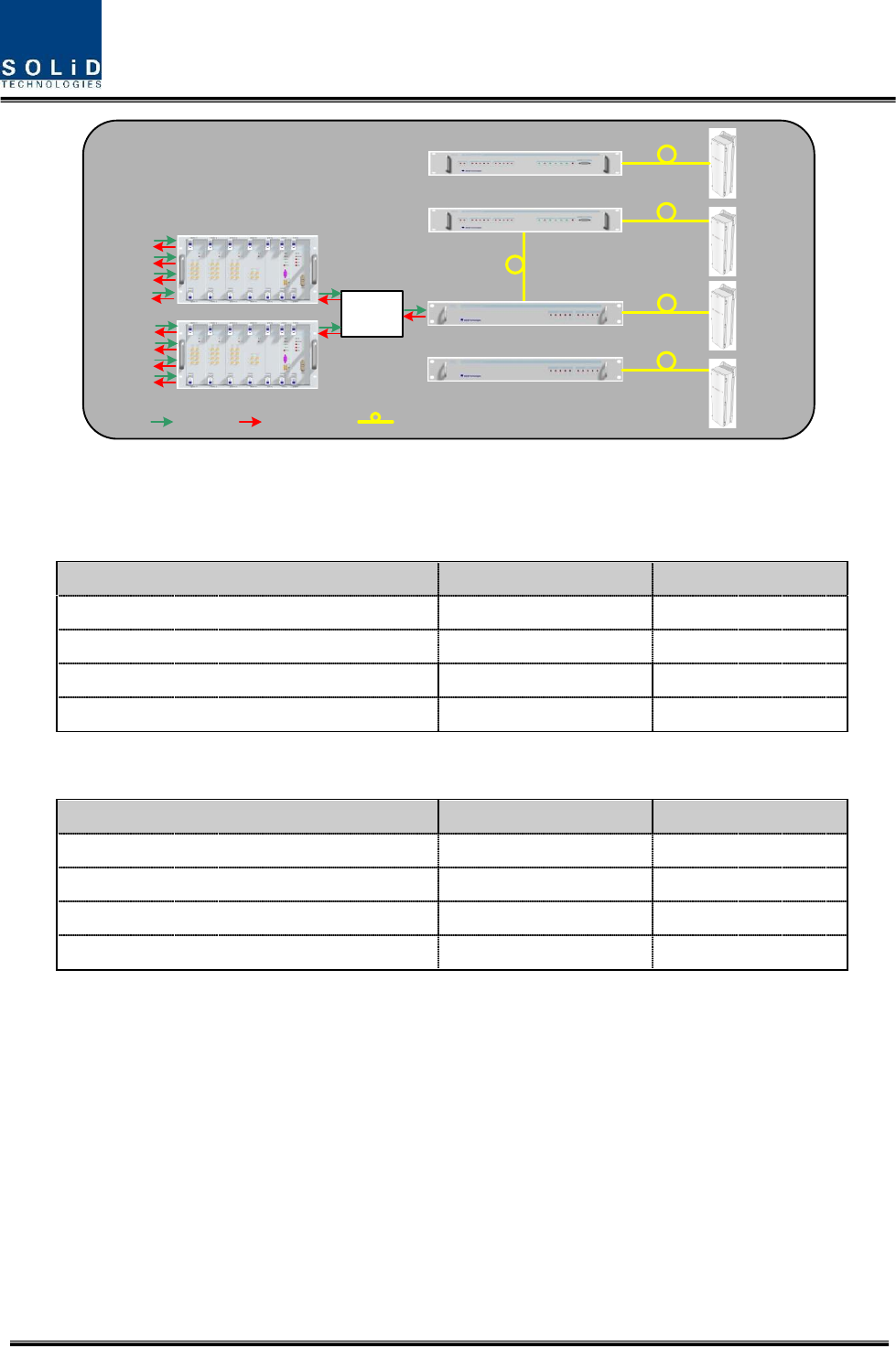
Confidential & Proprietary 13/43
BIU
(Master)
BIU
(Slave)
2Way
Divider
850C
700L_S,M
1900P
2100A
Max 5dBo
Max 5dBo
.
.
.
.
.
.ROU#1
ROU#32
.
.
.
.
.
.
ROU#1
ROU#28
.
.
.
.
.
.
ODU#1
ODU#4
OEU#4
OEU#1
RF Tx RF Rx
Max 5dBo
Max 5dBo
Max 5dBo
Optic cable
Expansion Configuration (DOU : OM4)
BIU(Max 2 Units)
ODU(Max 4 Units)
ROU(Max 60 Units)
2100A_M
800P,900I
700P
2500T
Figure 2. Expansion system topology
System topology Charts (OM4; 4Optical port)
System elements
Optical Loss [dBo]
Max. RUs
BIU – ODU(DOUx1) – ROU
1~5dBo
4
BIU – ODU(DOUx2) – ROU
1~5dBo
8
BIU – 4ODU(DOUx2) – ROU
1~5dBo
32
BIU – 4ODU(DOUx2)-4OEU(DOUx2) – ROU
1~5dBo
60
System topology Charts (OM1; 1Optical port)
System elements
Optical Loss [dBo]
Max. RUs
BIU – ODU(DOUx1) – ROU
1~10dBo
1
BIU – ODU(DOUx2) – ROU
1~10dBo
2
BIU – 4ODU(DOUx2) – ROU
1~10dBo
8
BIU – 4ODU(DOUx2)-4OEU(DOUx2) – ROU
1~10dBo
12

Confidential & Proprietary 14/43
Section3
System configuration and Functions
3.1 HROU (High power Remote Optic Unit)
3.1 HROU (High power Remote Optic Unit)
HROU consists of two unit, one is HMRU(High power Main Remote Unit) and the other is HARU(High
power Add-on Remote Unit).
The biggest difference between HMRU and HARU is whether R-OPTIC module exist or not in the
enclosure.
HMRU receives TX optical signals from ODU and converts them into RF signals. The converted RF signals
are amplified through High Power Amp in a corresponding HRDU band combined with UDCU, PAU and
Cavity duplexer, and then radiated to the antenna port.
When receiving RX signals through the antenna port, this unit filters out-of-band signals in a
corresponding HRDU and sends the results to R-OPTIC to make electronic-optical conversion of them.
After converted, the signals are sent to a upper device of ODU. HMRU can be equipped with up to four
HRDUs (High Remote Drive Unit) and the module supports single band only.
HARU receives TX RF signal from HMRU and amplifies through High Power Amp in a corresponding
HRDU combined with UDCU, PAU and Cavity duplexer, and then radiated to the CU(Combining Unit)
When receiving RX signals through the antenna port, HHRDU filters out-of band signal in a
corresponding HRDU and sends the results to MHRU through RF cable.
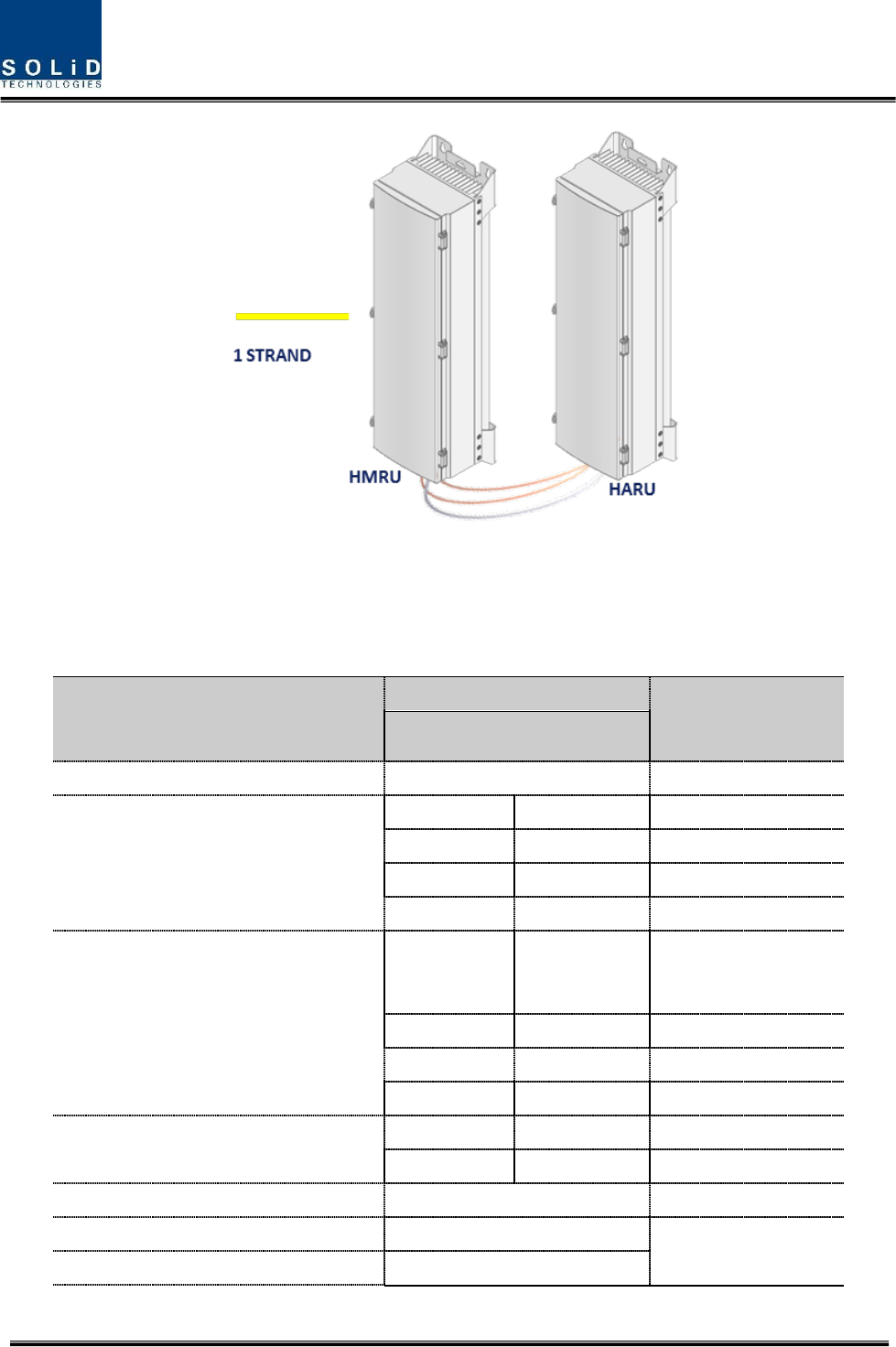
Confidential & Proprietary 15/43
Figure 3. HROU outer Look
3.1.1 Specifications of HROU
Item
Spec.
Remark
HMRU
The rated mean output Power per band
44dBm
25W per band
The nominal downlink bandwidth
LTE700
28MHz
728~756MHz
850IC
32MHz
862 - 894MHz
1900P
65MHz
1930 - 1995MHz
2100A
45MHz
2110 - 2155MHz
The nominal uplink bandwidth
LTE700
17MHz and
10MHz
699 ~ 716MHz
777 ~ 787MHz
850IC
32MHz
817 - 849MHz
1900P
65MHz
1850 - 1915MHz
2100A
45MHz
1710 - 1755MHz
The nominal passband gain
Downlink
59dB
each band
Uplink
45dB
each band
Input/ Output Impedance
50 ohm
Weight
39 Kg
Common Part
Power consumption
50W
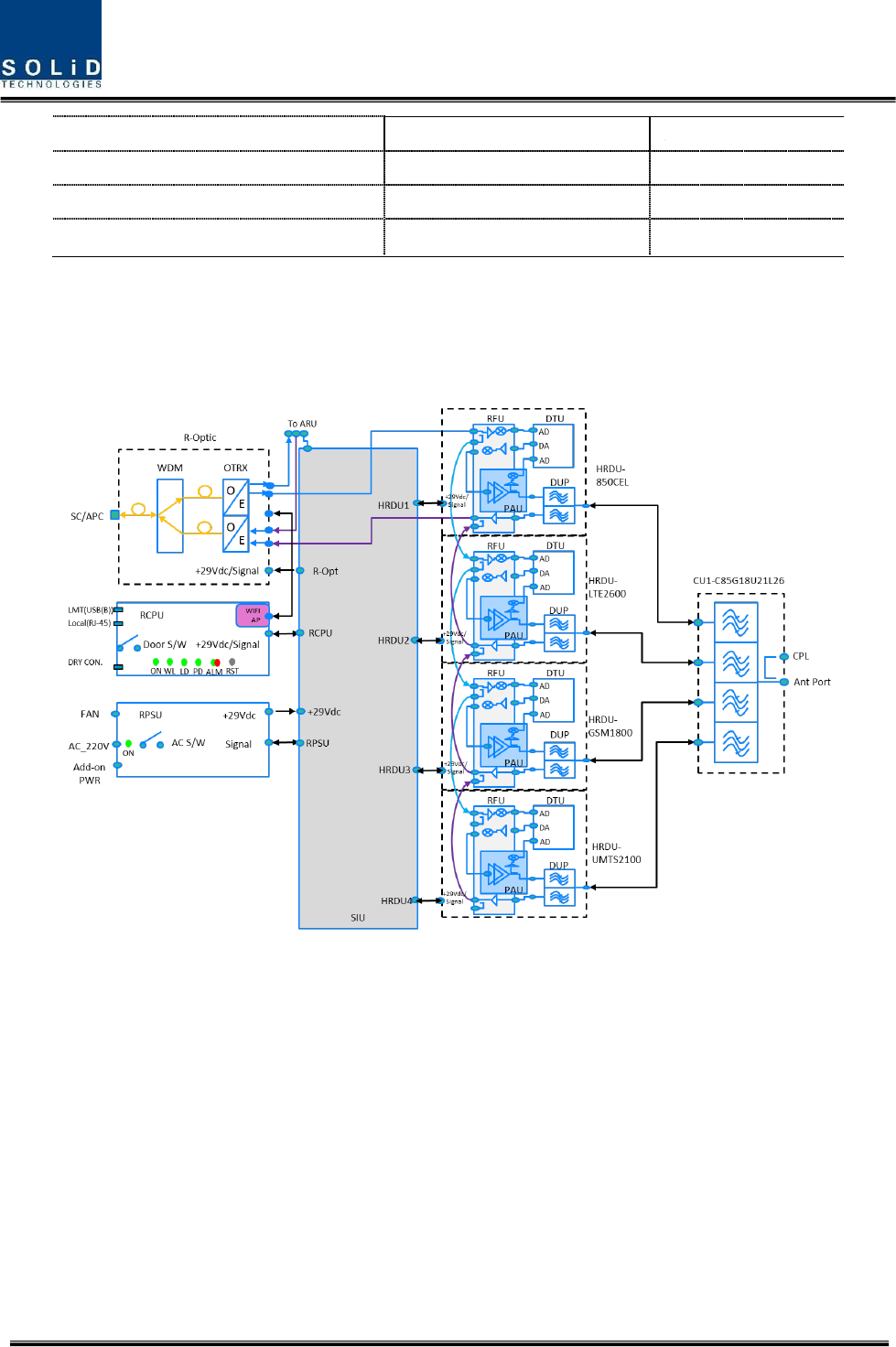
Confidential & Proprietary 16/43
Temperature range
-25°C to +55°C/ -13 to 131°F
Ambient Temperature
Humidity Range
0% ~ 90%
Non-condensing
Sealing (Remote Unit)
IEC 60 529 EN 60 529
IP66 Complaint
Size(mm)
320 x 1165 x260
Including Bracket
3.1.2 Block Diagram of HROU
3.1.2.1 HMRU block diagram
Figure 4. HMRU Block diagram
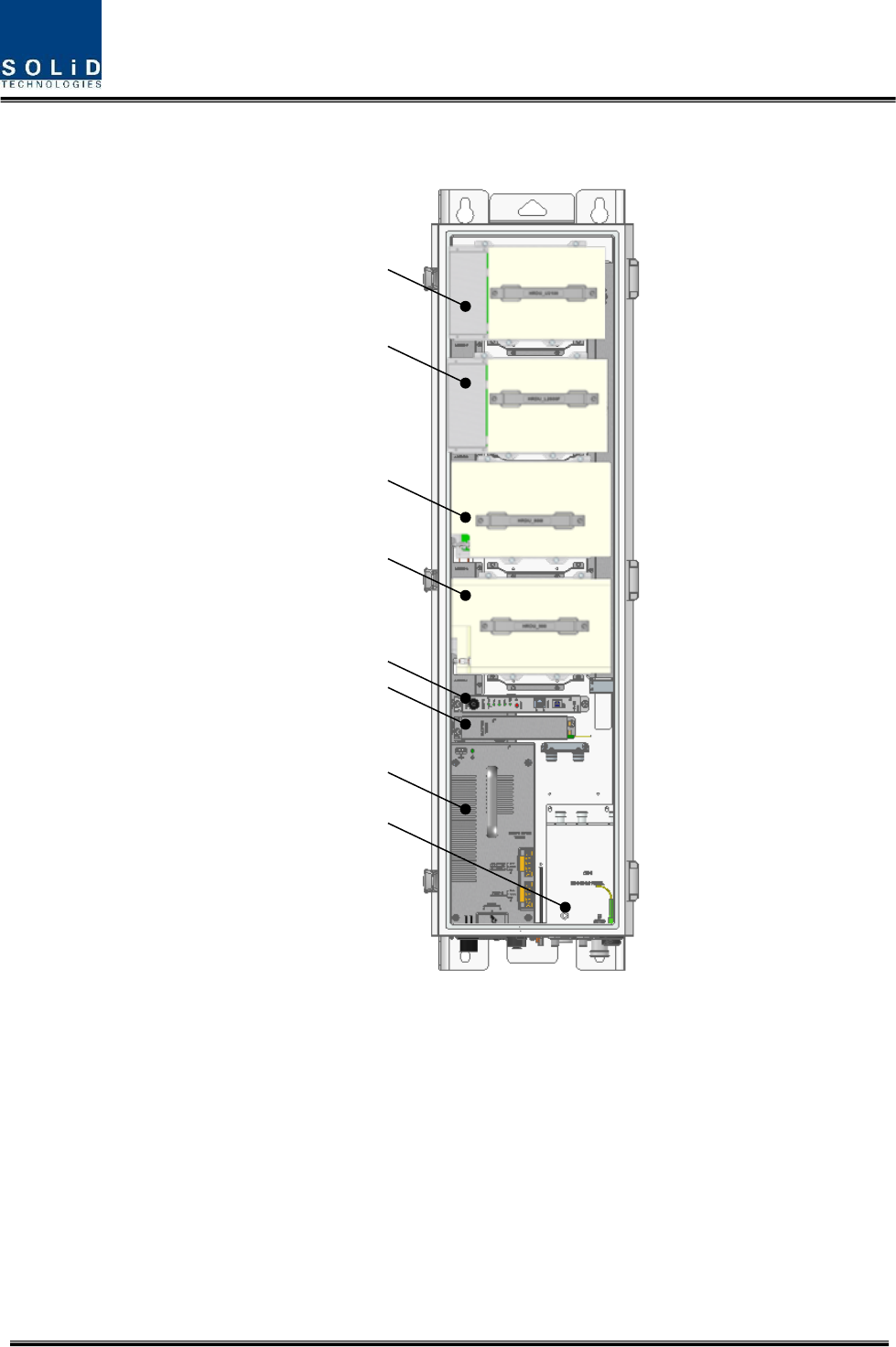
Confidential & Proprietary 17/43
3.1.2.2 HROU inner look
HRDU#4
HRDU#3
HRDU#2
HRDU#1
R-OPTIC
RPSU
CU
RCPU
Figure 5. Inside of Remote Unit

Confidential & Proprietary 18/43
3.1.2.3 HROU part list
No.
Unit
Description
Remark
1
HRDU X4
High Remote Drive Unit
Consist of UDCU, PAU and cavity filter
Filter and high amplify TX signals;
Filter and amplify RX signals in low noise amplifier;
Remove out-of signals through cavity duplexer
Optional
Max 4
2
RPSU(AC)
Remote Power Supply Unit
Input power: 120 VAC(108~132V)
Output power: +29 VDC
RPSU(DC)
Remote Power Supply Unit
Input power: -48 VDC(-40.8 ~ -57.6V)
Output power: +29 VDC
3
R-OPTIC
Remote Optic
Make RF conversion of TX optical signals;
Convert RX RF signals into optical signals;
Compensates optical loss;
5dBo optical link between ODU(OM4) and ROU;
10dBo optical link between ODU(OM1) and ROU;
Fiber Connector: SC/APC Connector;
Optical Wavelength: 1310/1550 WDM;
Communicates with BIU/OEU though the FSK modem
4
RCPU
Remote Central Processor Unit
Controls signal of each unit
Monitors BIU/ODU/OEU status through FSK modem
communication
5
CU_1A70851921
Multiplexer1
Combine TX signals from 4 HRDUs; Distribute RX signals to
4 HRDUs
CU_2A70851921
Multiplexer2
Combine TX signals from 2 HRDU ;Distribute RX signals to
2 HRDUs of low frequency under 1GHz
Combine TX signals from 2 HRDUs; Distribute RX signals to
2 HRDUs of high frequency over 1GHz
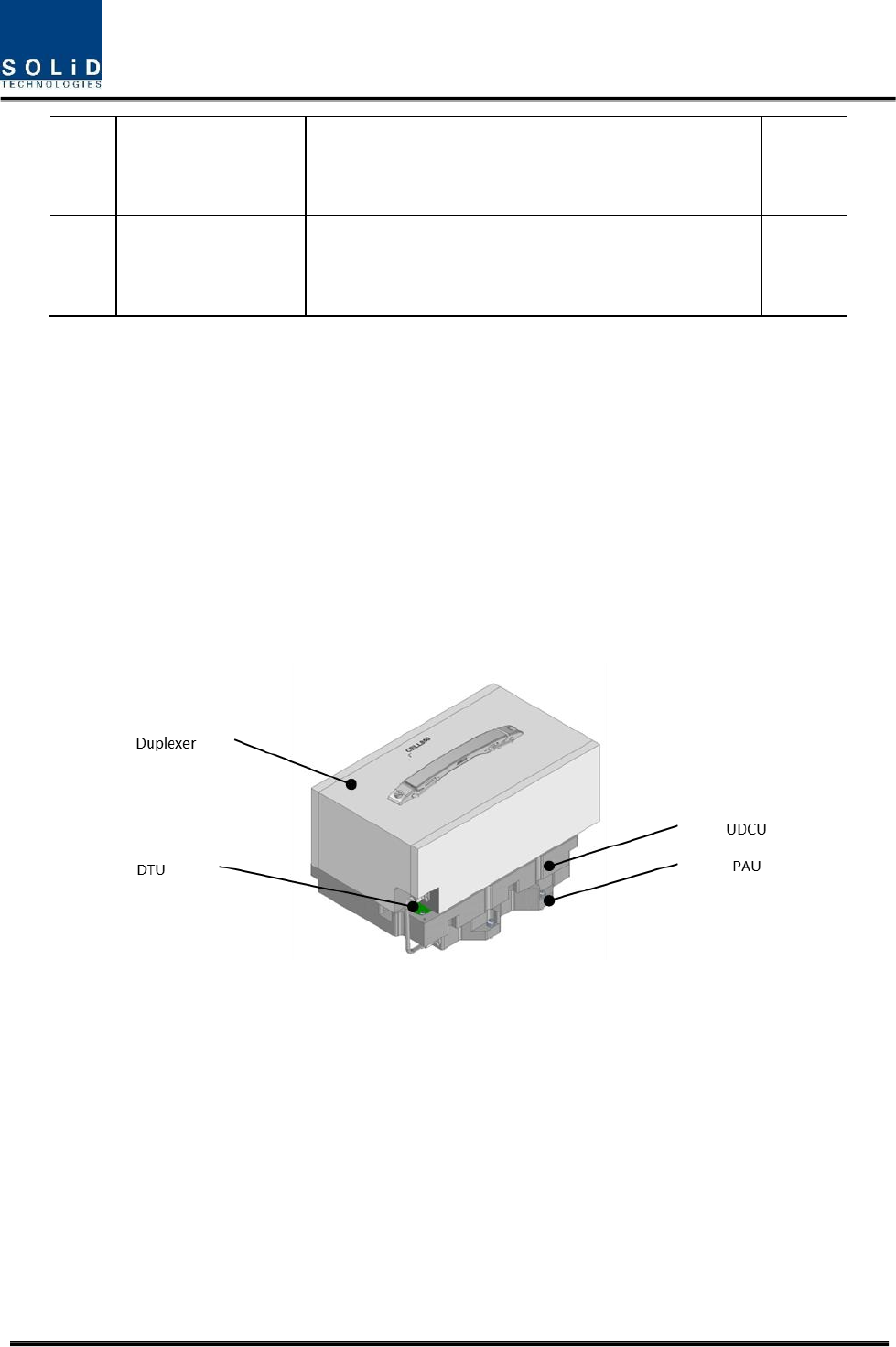
Confidential & Proprietary 19/43
6
Enclosure
Enclosure to satisfy NEMA4(IP66);
Wall mounting(Vertical Mount)
7
SIU
System Interface Unit
Distribute power and signals of each module
3.1.3 Function by unit
3.1.3.1 High Remote Drive Unit (HRDU)
When receiving TX signals from each band through Remote Optic, HRDU filters the signals and amplifies
them with High Power Ampifier. The unit also filters RX signals given through cavity filter and amplifies
them to send the signals to Remote Optic.In the unit, there is ATT to adjust gain. HRDU consist of UDCU,
DTU, PAU and cavity duplexer like below figure and all modules are merged with one package
Figure 6. HRDU Outer Look
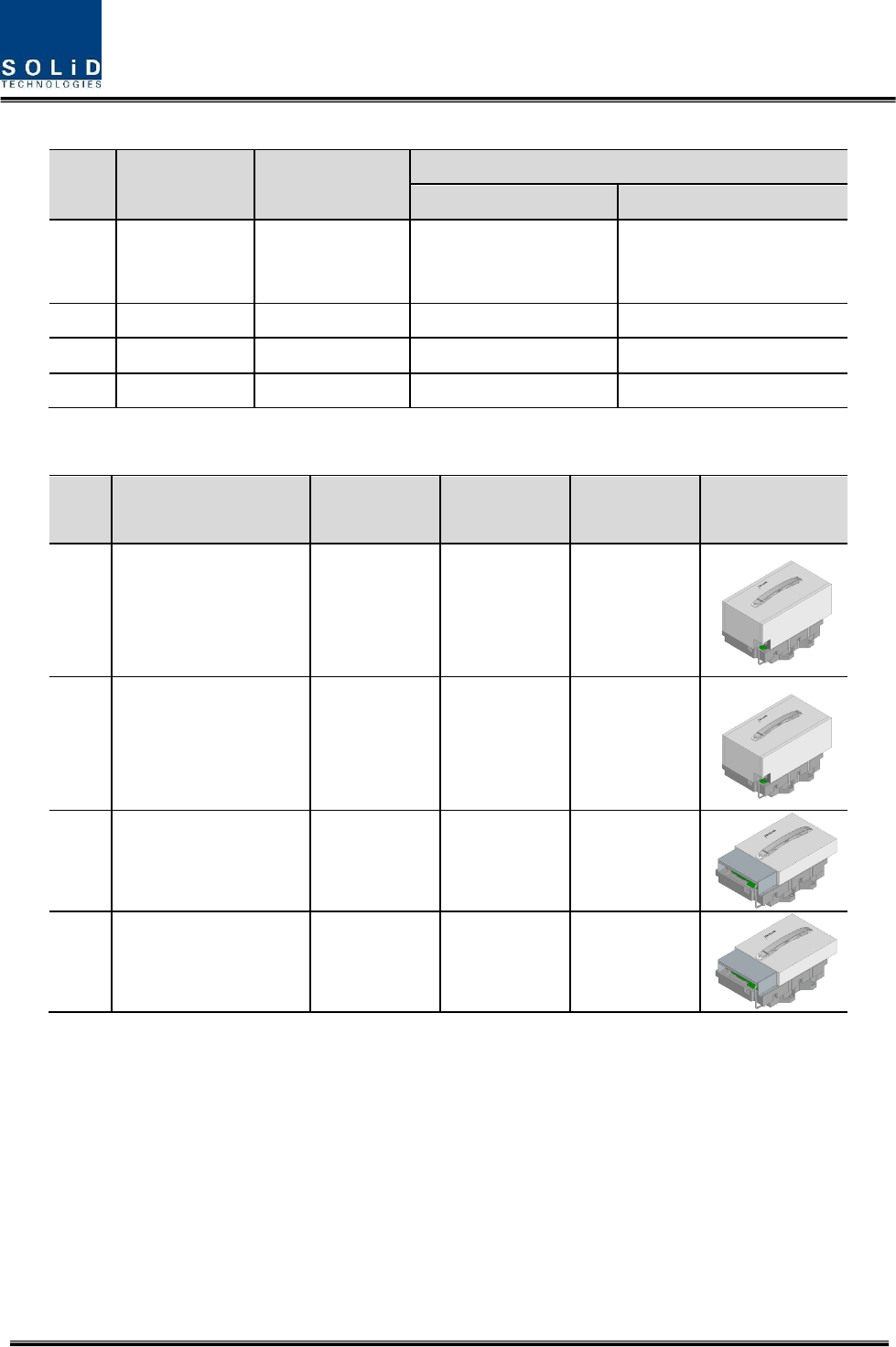
Confidential & Proprietary 20/43
HRDU devices are varied for each frequency band , including the following:
No
Unit naming
Description
Frequency (Bandwidth )
TX
RX
1
N20-HRDU-L700
Single band
728~756MHz
699 ~ 716MHz
777 ~ 787MHz
2
N20-HRDU-850IC
Single band
862 - 894MHz
817 - 849MHz
3
N20-HRDU-1900P
Single band
1930 - 1995MHz
1850 - 1915MHz
4
N20-HRDU-2100A
Single band
2110 - 2155MHz
1710 - 1755MHz
No
Unit naming
Dimension
Weight
Power
consumption
Outlook
1
N20-HRDU-L700
233 X 155 X 148
6.2kg
140W
2
N20-HRDU-850IC
233 X 155 X 143
5.6kg
150W
3
N20-HRDU-1900P
233 X 155 X 131
4.5kg
150W
4
N20-HRDU-2100A
233 X 155 X 98
3.4kg
130W
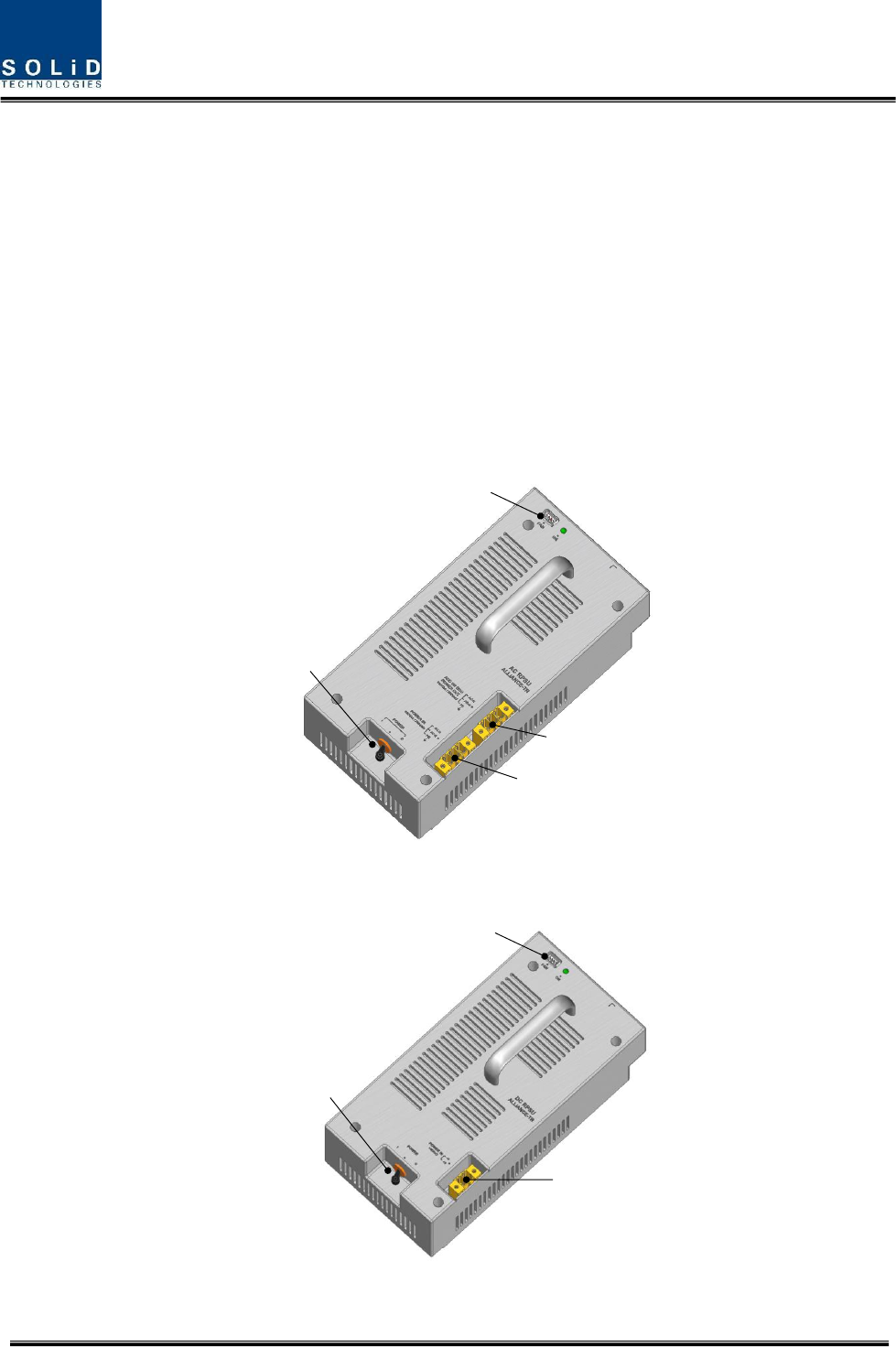
Confidential & Proprietary 21/43
3.1.3.2 Remote Power Supply Unit ( RPSU)
There are 2types of RPSU in the HROU for supply to active module in the enclosure and receive power
from external.
They are the DC/DC PSU receiving input -48V and the AC/DC PSU receiving input 120V from external.
As order, either of the two types should be decided. MS Connector, which uses ports to receive inputs,
is designed to accept any of AC and DC. Only in this case, the input cable is different.
RPSU has a circuit brake to turn the power ON/OFF and has LED indicator at the top to check if input
power is normally supplied.
POWER SWITCH
FAN CON
POWER IN
ADD-ON ROU
POWER OUT
Figure 7. AC-DC RPSU Outer Look
POWER IN
POWER SWITCH
FAN CON
Figure 8. DC-DC RPSU Outer Look
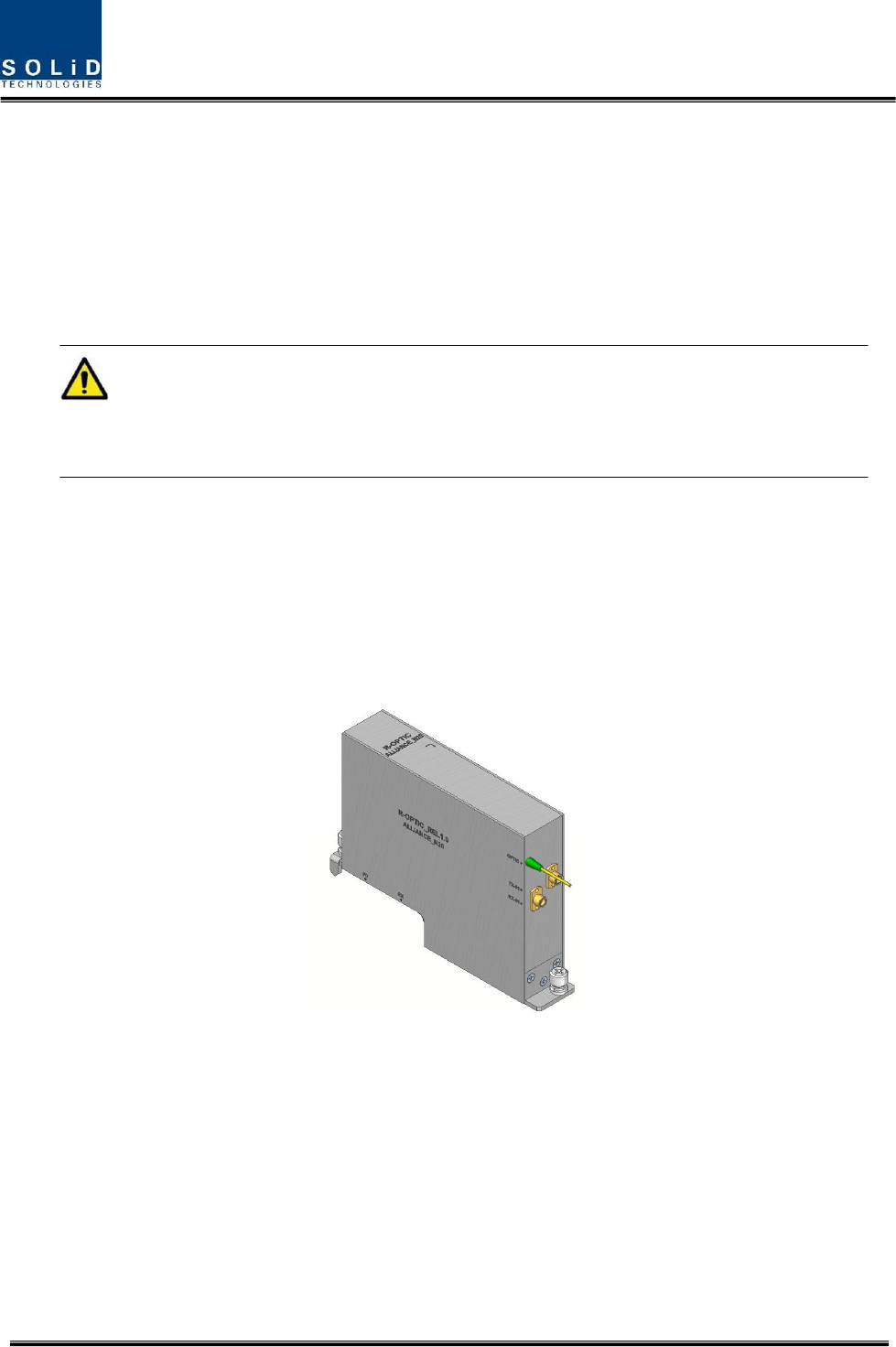
Confidential & Proprietary 22/43
Functions:
Providing a circuit breaker to turn AC power ON/OFF
Providing DC power each HRDU
Providing DC power and signal to FAN tray
LED indicators for showing alarm staus of PSU
Caution
DOUBLE POLE/NEUTRAL FUSING
3.1.3.3 Remote Optic(R OPTIC)
Remote Optic converts optical signals into RF signals and performs vice versa. It also has internal ATT for
optical compensation to compensate for optical cable loss. It provides two path in pairs(TX/RX) to
transport RF signal to ARUs
Figure 9. R OPTIC Outer Look
3.1.3.4 Remote Central Processor Unit (RCPU)
RCPU can monitor and control each module of HROU. This unit receives and analyzes upper
communication data from Remote Optic and reports the unit's own value to upper devices. At the front
of the module, it has LED indicator to show system status, letting you check any abnormalities at a time.
At the same front, it also has communication LED Indicators to show communication status with upper
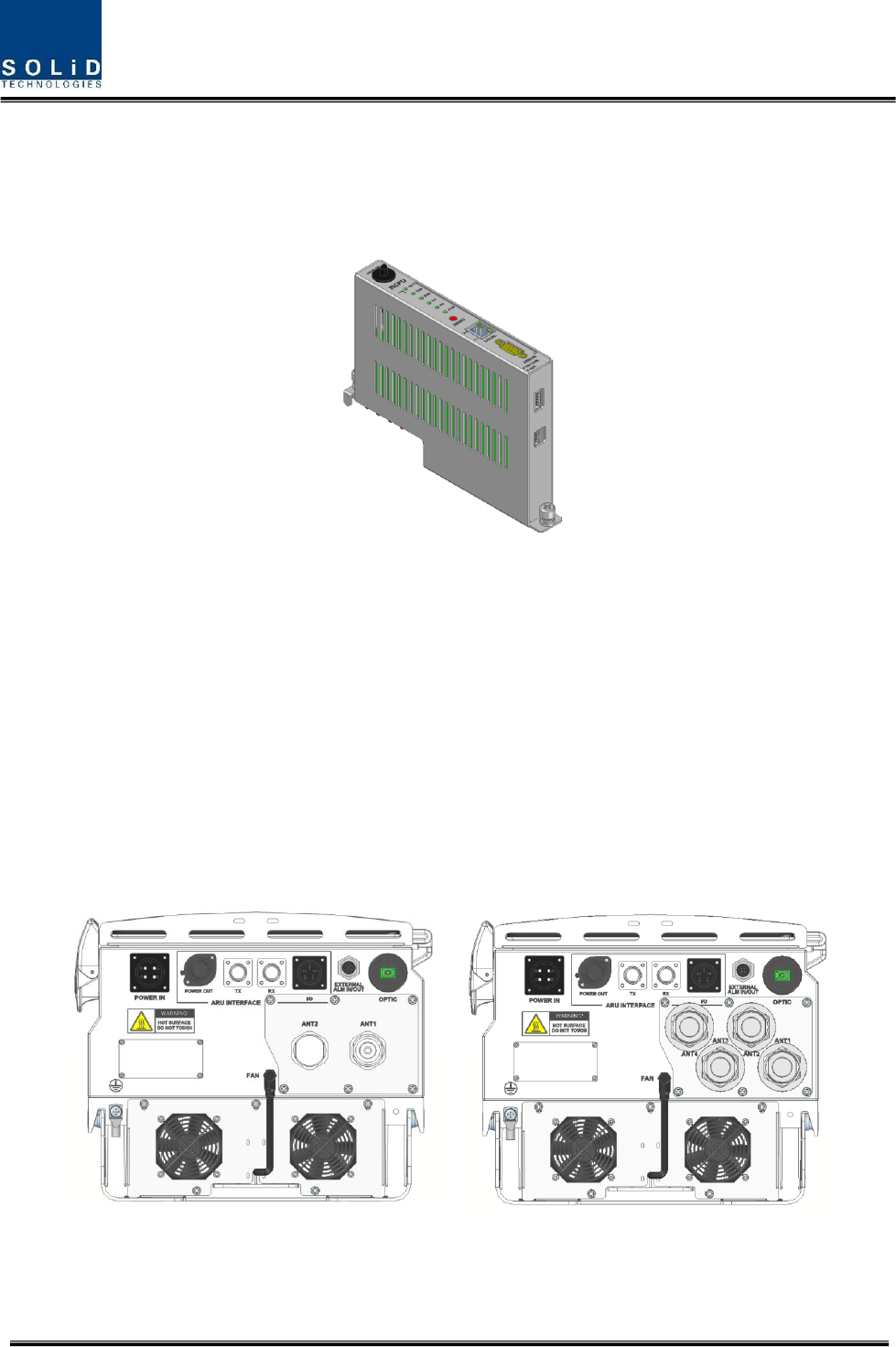
Confidential & Proprietary 23/43
devices. Through Local port, the unit enables you to check and control device status through PC and
laptop.
It provides three interface port with ARUs to communicate with these. It also provide dry contact port,
which is (1) output port and (1) input port
Figure 10. RCPU Outer Look
3.1.4 Bottom of HROU
3.1.4.1 Functions
The Bottom look of HROU depends on the CU(combine unit) option . Basically, The CU has two
antenna ports.
But , If not need to install CU in the enclosure, The number of antenna ports on the bottom of HROU will
be change 4 ports with DIN- type .
Figure 11. The Bottom Look of HROU

Confidential & Proprietary 24/43
No
Port
HMRU
Remark
1
Optical Port
1EA
SC/APC, Waterproof
2
ARU Interface
1EA,
(1)CON,(2)SMA-Female
3
ANT1
1EA
DIN-type female
4
ANT2
1EA
DIN-type female
5
ANT3
1EA
DIN-type female
6
ANT4
1EA
DIN-type female
7
AC Power IN
Or DC Power IN
1EA
MS-Con, Waterproof
8
AC Power OUT
1EA
MS-Con, Waterproof
9
EXT-FAN
1EA
Waterproof-Con

Confidential & Proprietary 25/43
Section4
System Installation
4.1 HROU Installation
This chapter describes how to install each unit and optical cables, along with power cabling method.
In detail, the chapter describes how to install shelves or enclosuers of each unit, Power Cabling method
and Optic Cabling and RF Interface. Furthermore, by showing power consumption of modules to be
installed in each unit, it presents Power Cabling budget in a simple way. Then, it describes the quantity
of components of modules to be installed in each unit and expansion method.
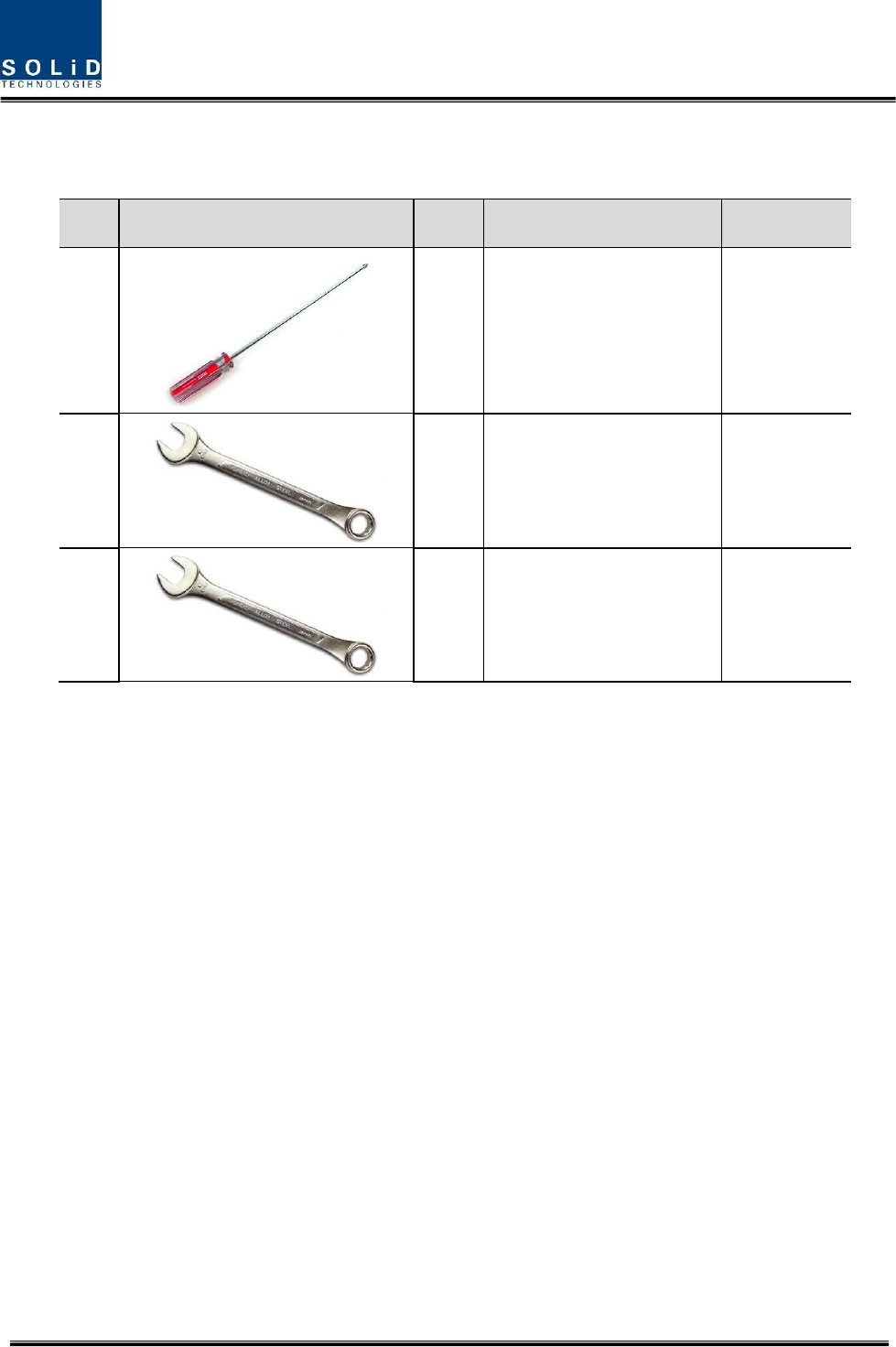
Confidential & Proprietary 26/43
4.1.1 Tools
Tools needed for installation is table below
No
Tools
Q’ty
Specification
Remark
1
1
+, 3Ø
Length is more than 20mm
For fixing
HRDU
2
1
33mm
To tighten
antenna port
3
1
19mm
To CU N-type
port
4.1.2 HROU Enclosure installation
HROU is designed to be water- and dirt-proof. The unit has the structure of one-Body enclosure. It
satisfies water-proof and quake-proof standards equivalent of NEMA4(IP65). The way to install for both
HMRU and ARU has same method. Basically HROU is attached with wall mountable bracket. HROU can
be mounted into either of wall or on a pole.
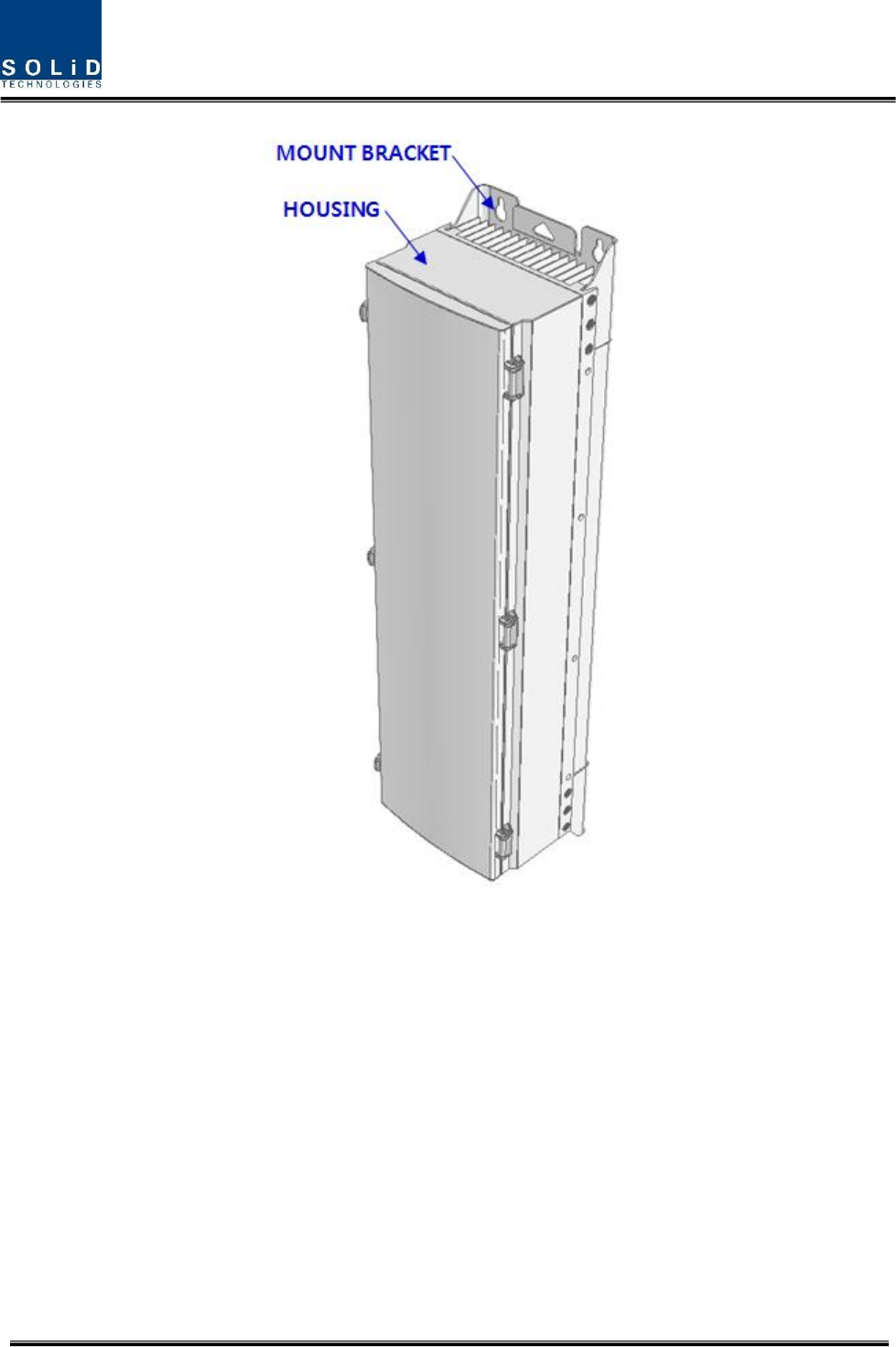
Confidential & Proprietary 27/43
Figure 12. How to install ROU
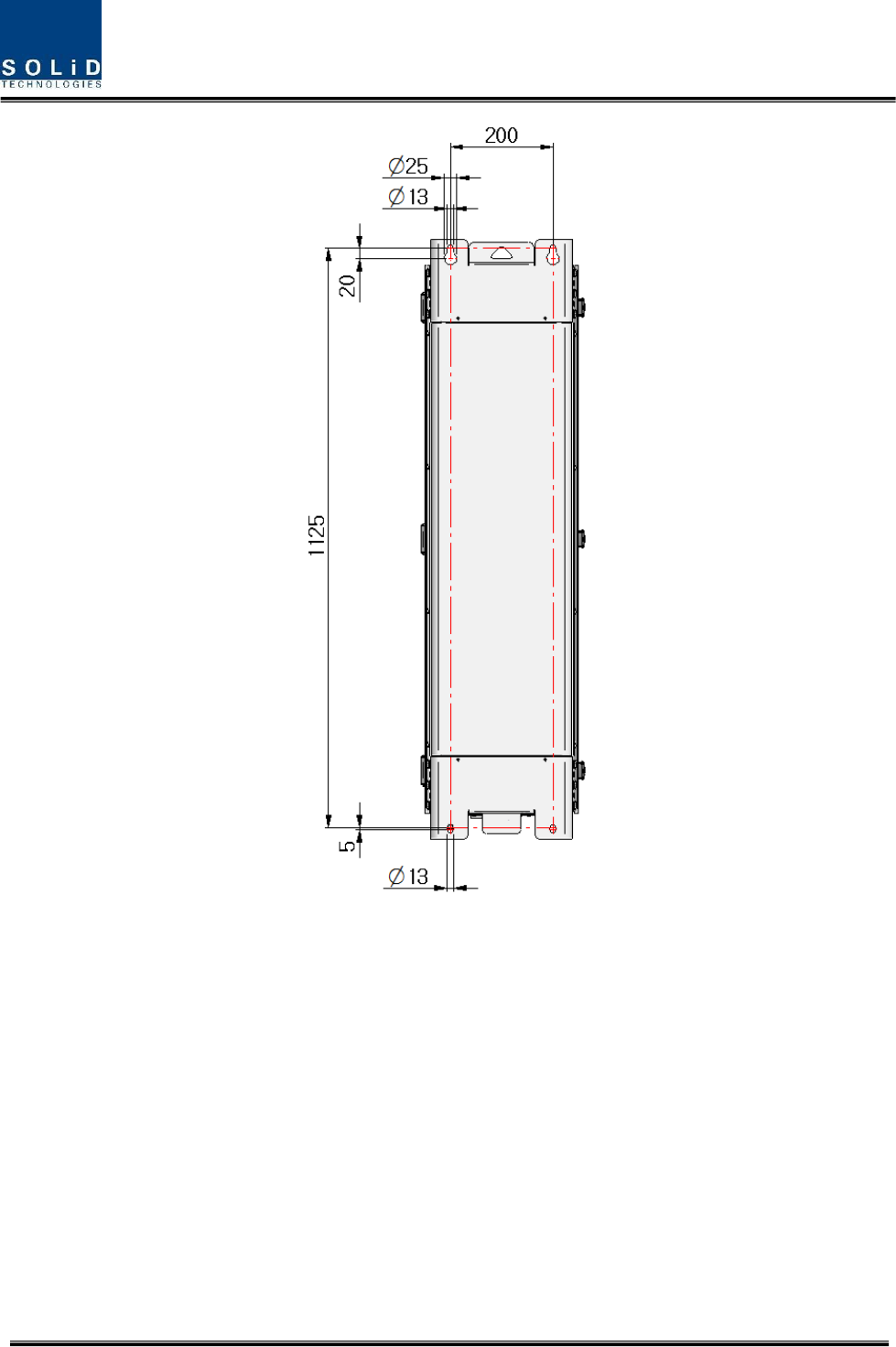
Confidential & Proprietary 28/43
Figure 13. Dimension used to install HROU on the WALL
4.1.3 HROU Wall Mount Installation
HROU’s installation bracket is attached on Enclosure when is delivered. It doesn’t need to remove
bracket to install enclosure. simply after installing 4 of M12 mounting bolts, secure 4 mounting bolts
tightly
First, install 2 of M12 mounting bolts roughly half way on the enclosure and install enclosure over the
bolts and secure tightly.
Second, install 2 of M12 mounting bolts under the enclosure and secure tightly
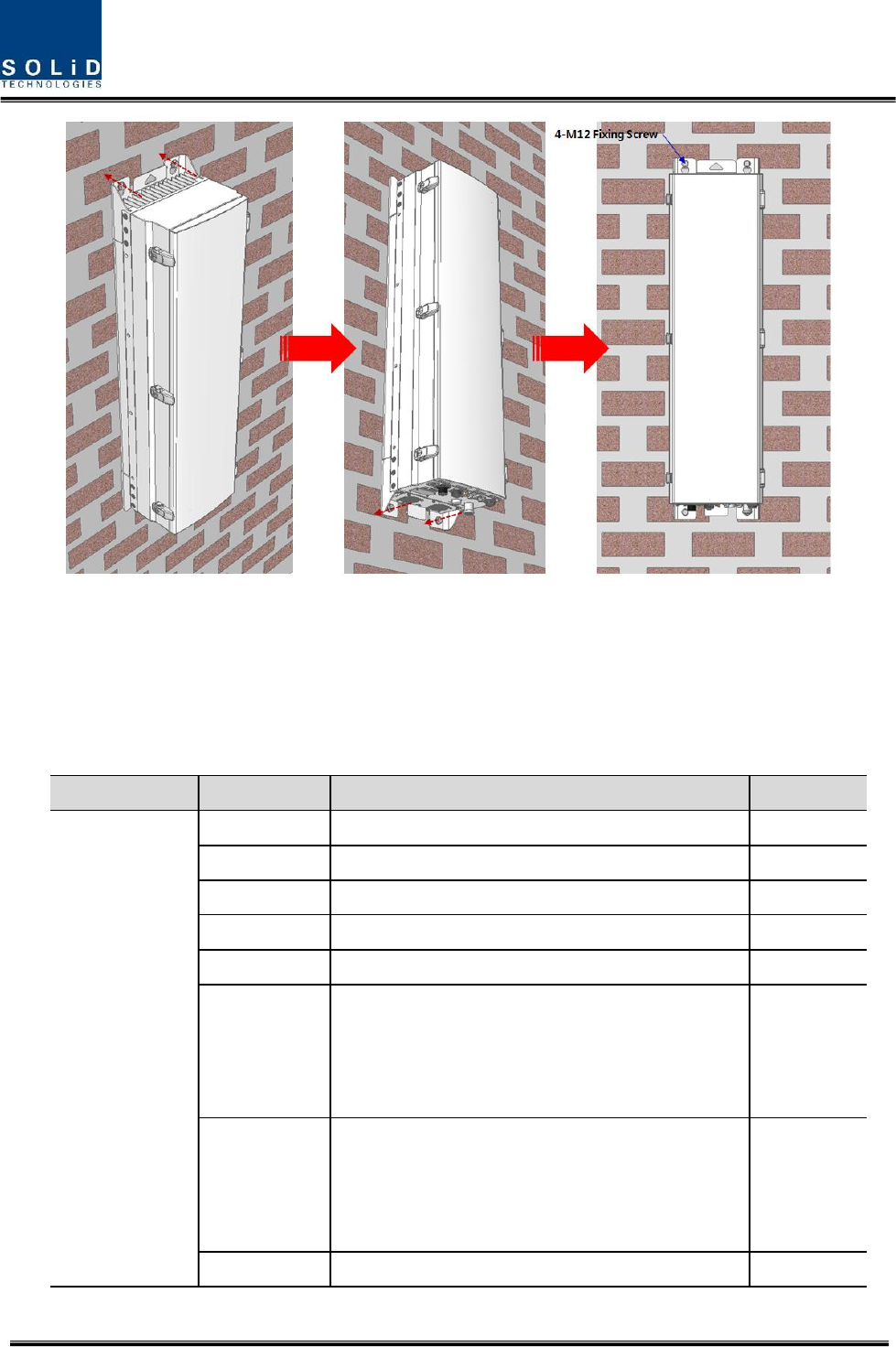
Confidential & Proprietary 29/43
Figure 14. Procedures of installation
4.1.4 HROU components
HROU has the following components:
No.
Unit
Description
Remark
Common Part
Enclosure
Including Wall mounting bracket
1EA
RCPU
-
1EA
R_OPTIC
With SC/ACP adaptor(only HMRU)
1EA,optional
RPSU
AC 110/220V or DC -48V
1EA
FAN UNIT
2 FANs is inside
1EA
CU_1
Combine TX signals from 5 HRDUs; Distribute RX
signals to 5 HRDUs;
Furthermore, there is reserved HRDU slot to support
2600LTE
ANT1
CU_2
Combine TX signals from 2 HRDU ;Distribute RX
signals to 2 HRDUs of low frequency under 1GHz
Combine TX signals from 2 HRDUs; Distribute RX
signals to 2 HRDUs of high frequency over 1GHz
ANT1 and
ANT2
Power Cable1
- MS Connector with 4 hole(AC and DC)
1EA, HMRU

Confidential & Proprietary 30/43
Power Cable2
- MS connector for HMRU connection with MS con
and Circular connector on the each side of end
1EA, HARU
HMRU
HRDU
Basically, the common part of HROU should have an enclosure and it is equipped with RCPU to inquire
and control state of each module, R_OPTIC to make both of electronic-optical and optical-electronic
conversions, RPSU to supply power for HROU. It should have Power Cable for external rectifier or to
supply required power.
In addition, HRDU can be mounted and removed to provide service for desired band.
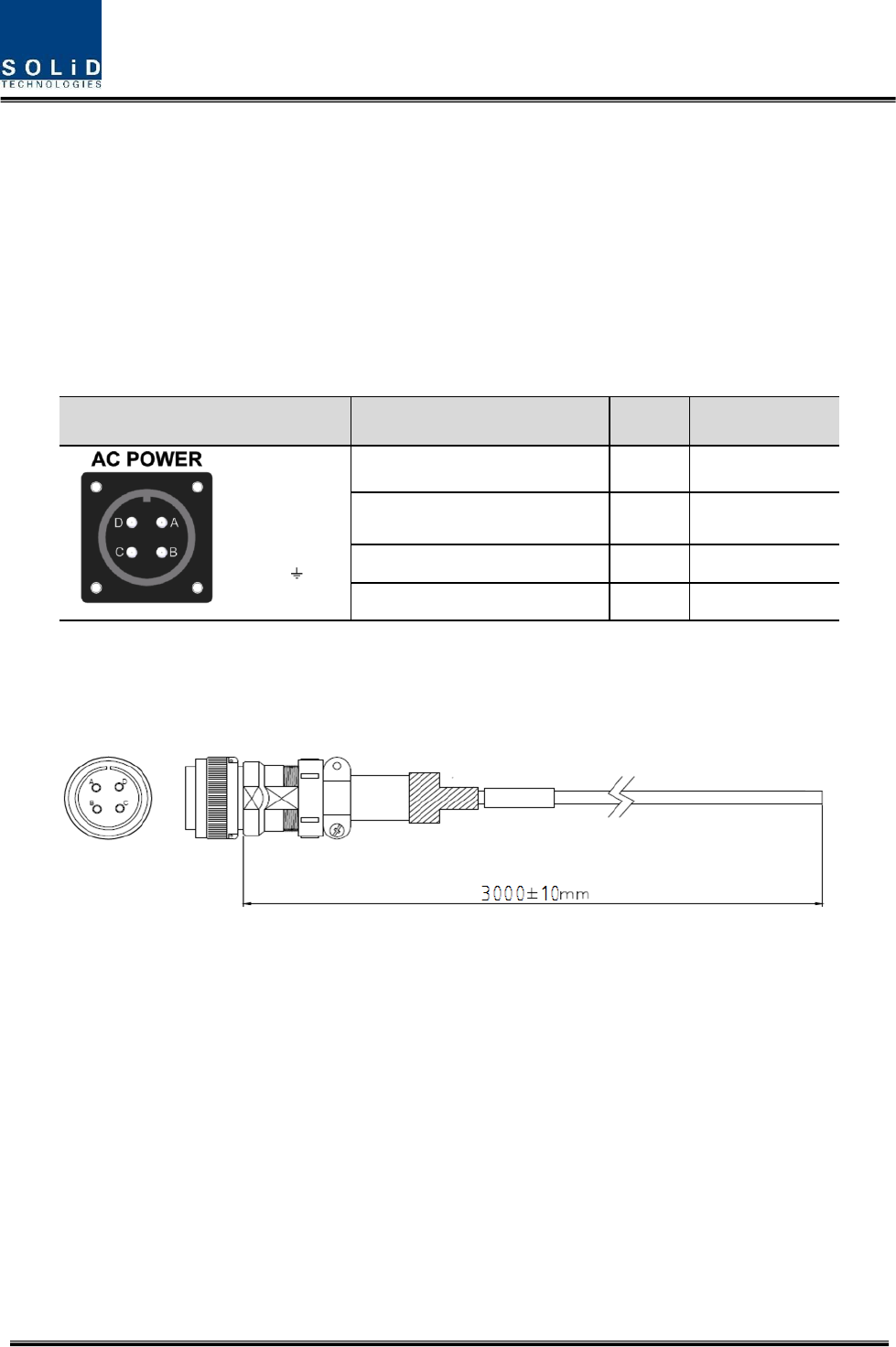
Confidential & Proprietary 31/43
4.1.5 HROU Power Cabling
AC Power
HROU supports AC110V/220V of input power. Provided outside power cable is only one type with
AWG#14 3m. Power cable is provided without power plug and it should be attached power plug based
on national’s power plug type
The pin discription of AC port is below. You should connect exact polarity of AC.
Port outlook
MS Connector numbering
Name
Description
A : AC_H
B : AC_N
C : N.C
D : F.G
A
AC_H
AC Hot
B
AC_N
AC Neutral
C
N.C
Not Connected
D
F.G
Frame Ground
Check if the connection is the same as one seen in the table above and make sure to turn the power ON.
Provided AC power cable’s outlook is below
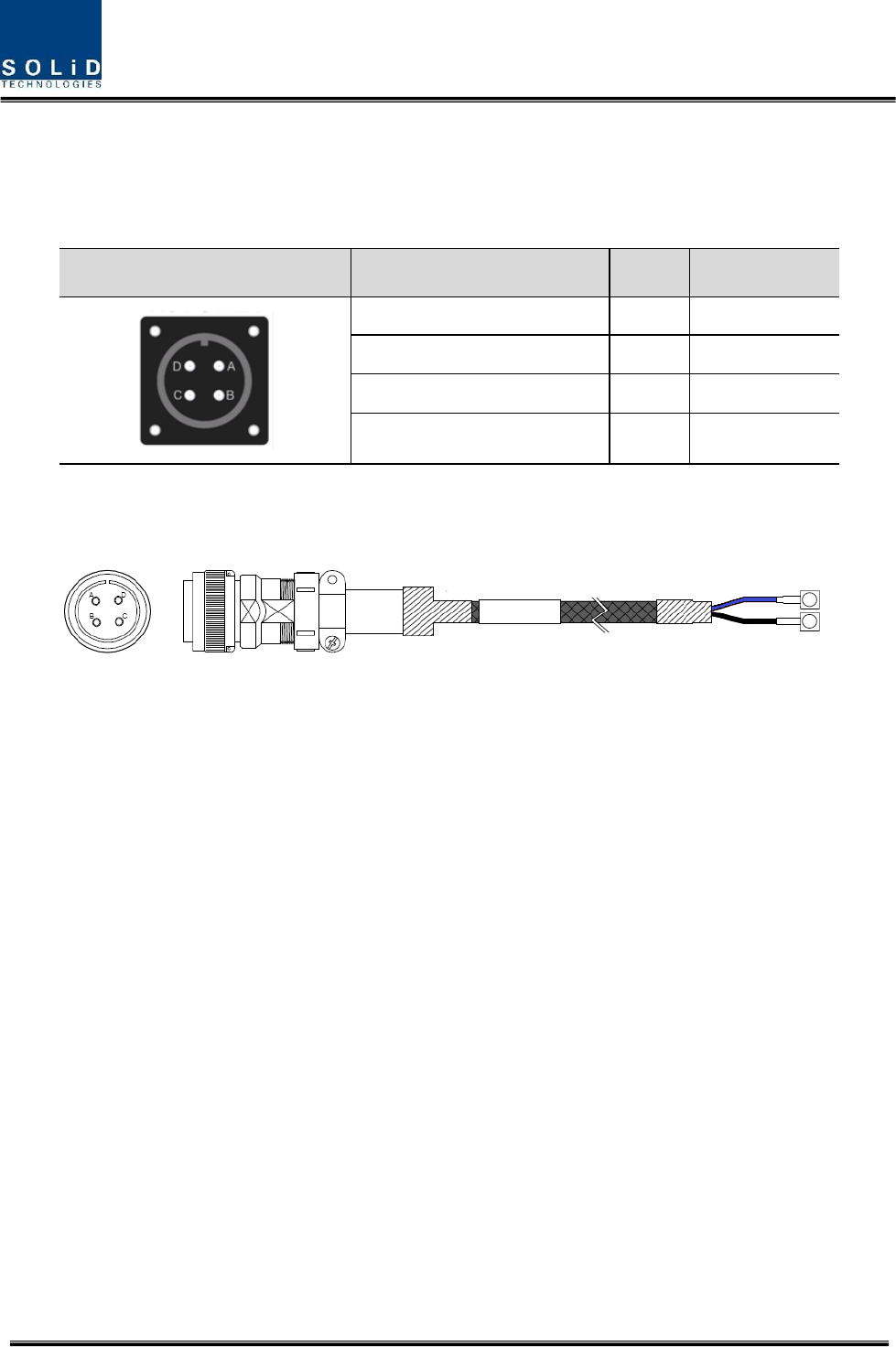
Confidential & Proprietary 32/43
DC Power
HROU supports only DC48V of input power. Provided outside power cable is only one type. The pin
discription of DC port is below. You should connect exact polarity of DC.
Port outlook
MS Connector numbering
Name
Description
A
N.C
Not Connected
B
N.C
Not Connected
C
+V
+48V
D
-V
-48V
Check if the connection is the same as one seen in the table above and make sure to turn the power ON.
Provided DC power cable’s outlook is below
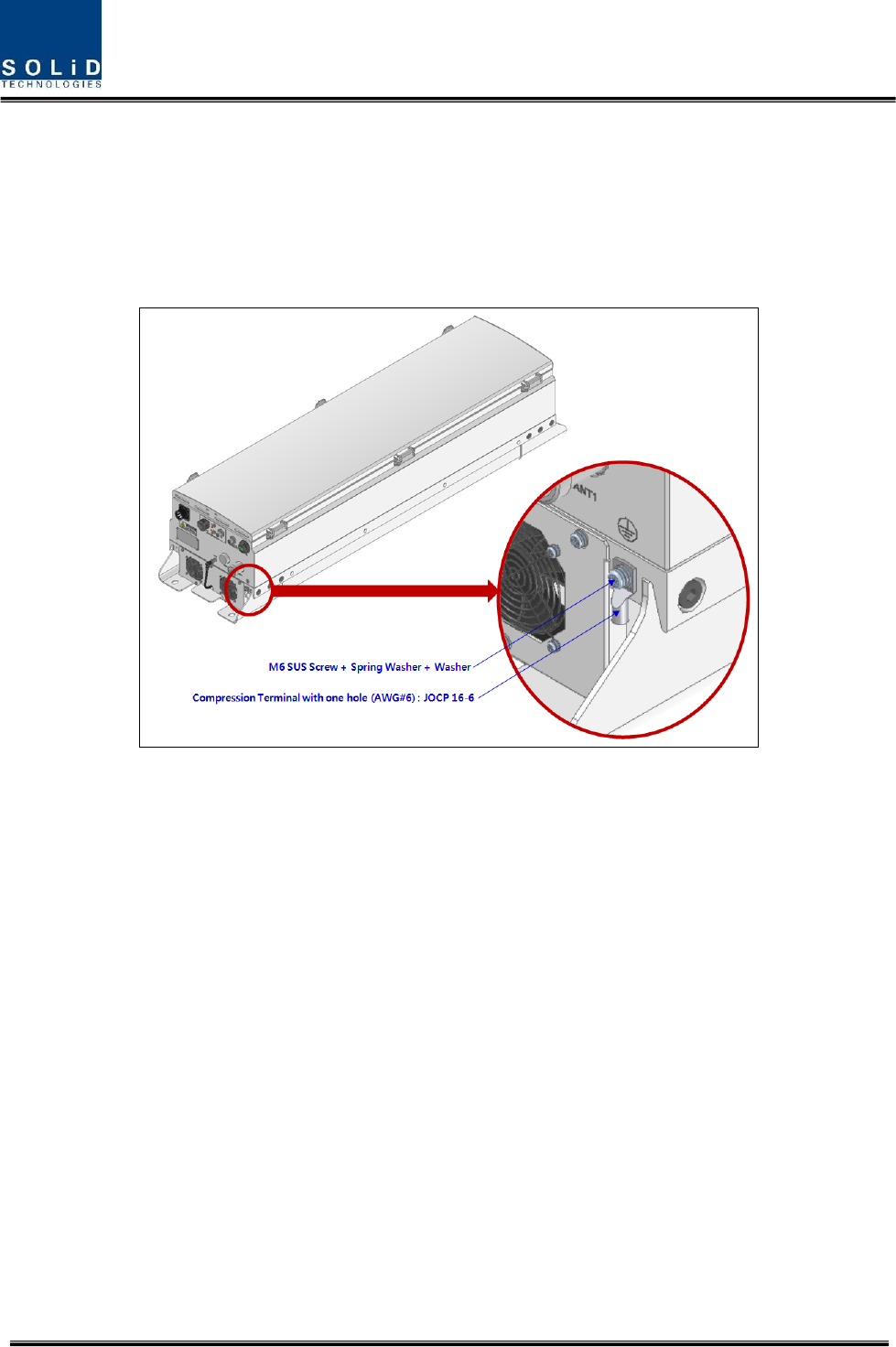
Confidential & Proprietary 33/43
4.1.6 HROU Ground cabling
The Grounding terminal is located at the bottom of HROU enclosure fixed by M6 screw. Compression
terminal is attached already when is delivered. The recommended thickness of cable is AWG#6 copper
grounding wire
Figure 15. Location of Ground Terminal
The specification of compression terminal is like below
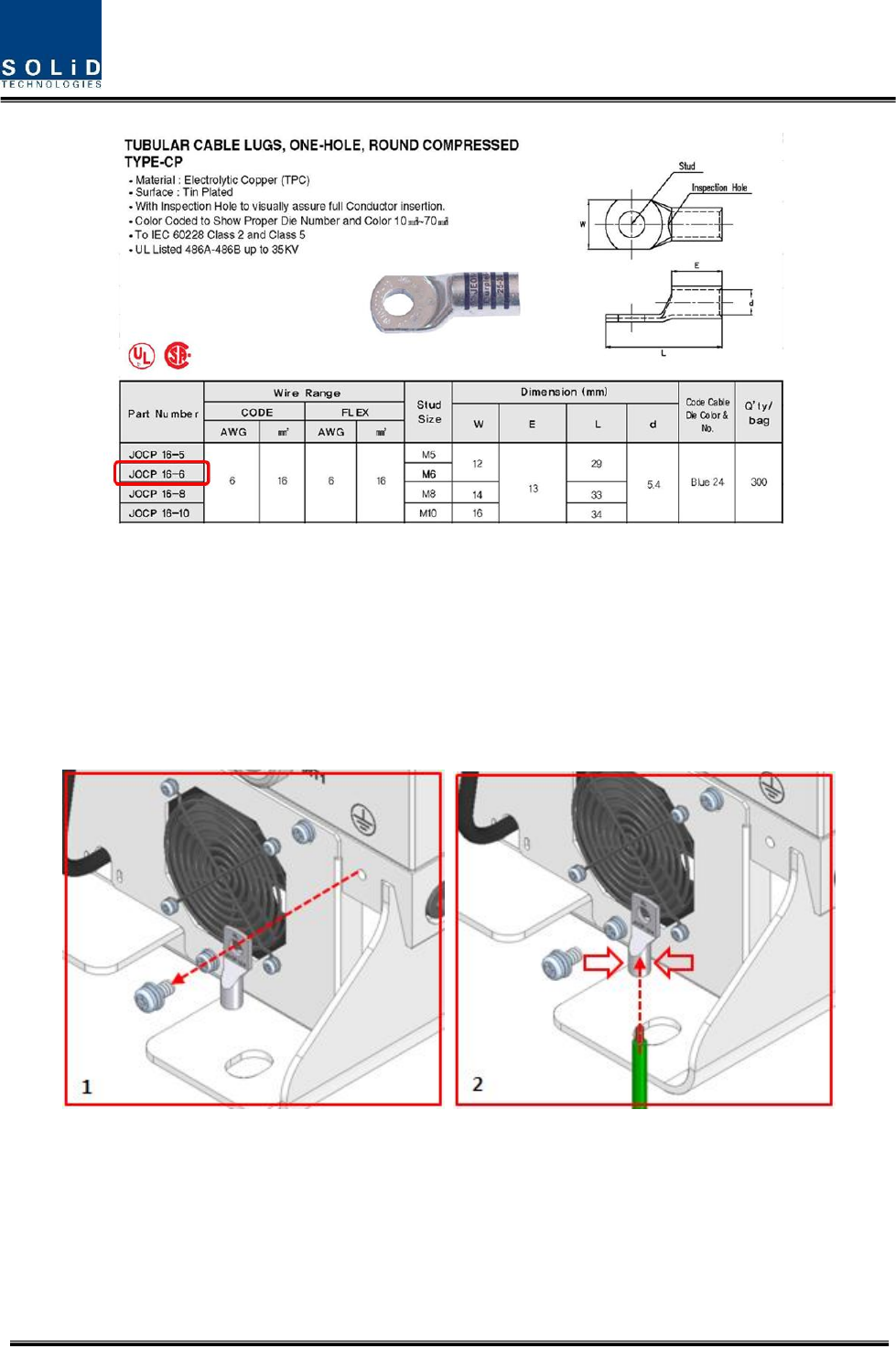
Confidential & Proprietary 34/43
Figure 16. Information of Terminal
The required part number is JOCT 16-6 supporting AWG 6. The way to install the grounding cable
comply with below procedures
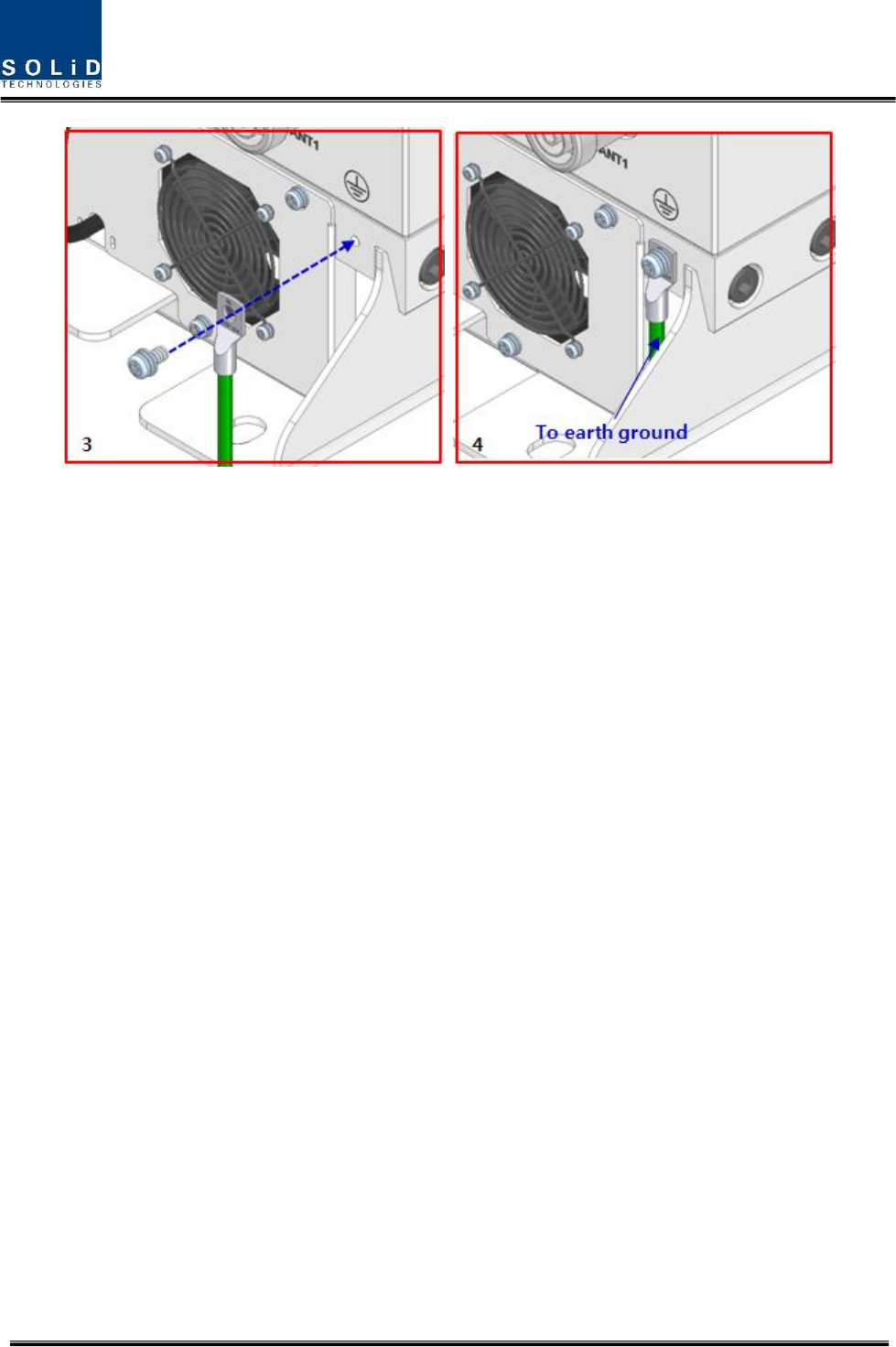
Confidential & Proprietary 35/43
Figure 17. How to install Ground Terminal
The procedures are
1. Loosen a two M6 screws and then take compression terminal off
2. Insert AWG#6 Grounding Wire into terminal and then compress a terminal using tool
3. Assemble the terminal which made in step “2” using 2xM6 screws
4. Cut the ground wire to proper length and connect it to the earth ground source
( Round terminals located on the side of a 1 mm2 (16 AWG) or more wires Using permanently
connected to earth.)
4.1.7 HROU Optical cabling
The Optical Connector is located at the bottom of Remote Unit enclosure fixed. Optical Cable can be
connected by using connectors.
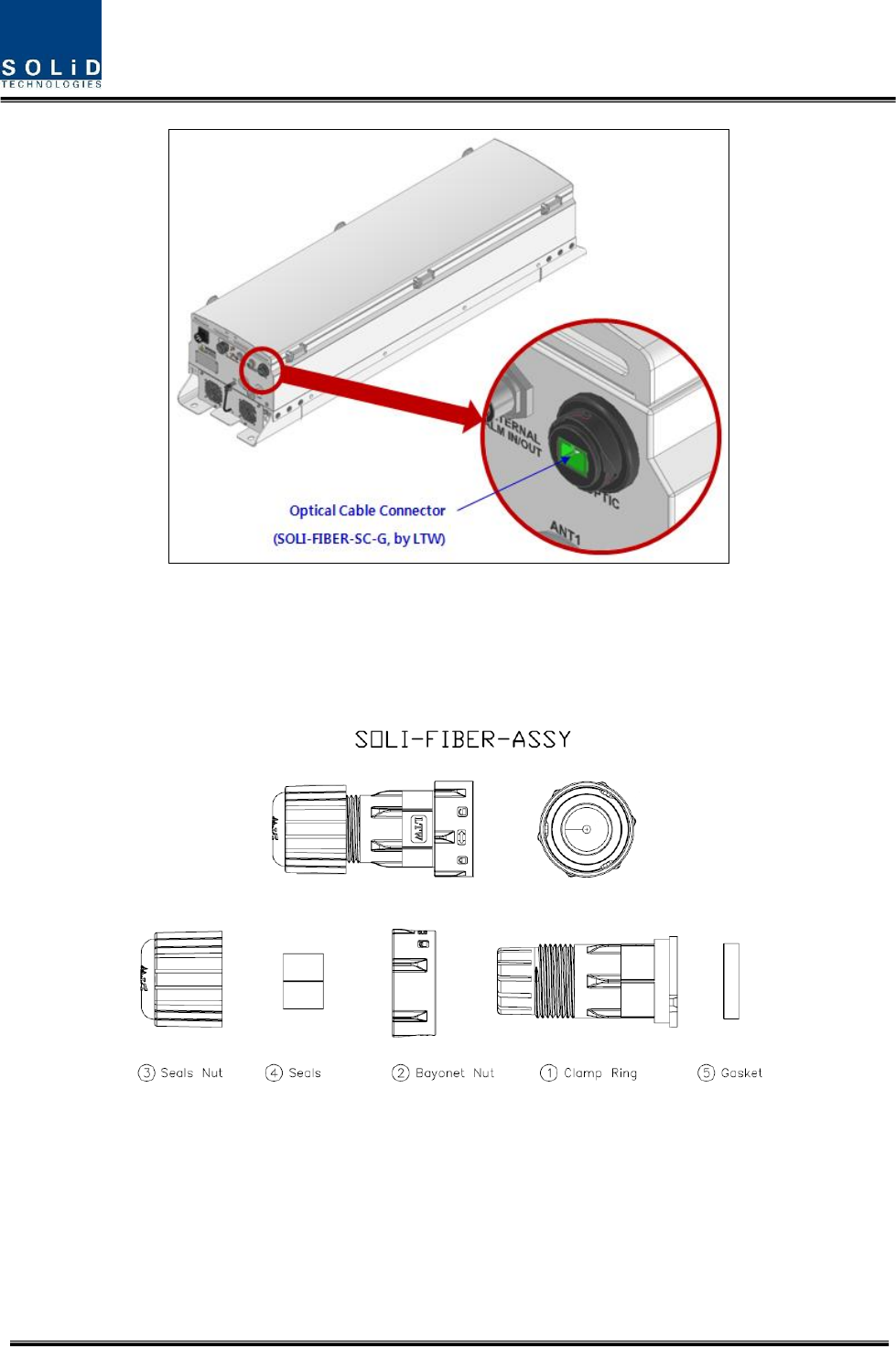
Confidential & Proprietary 36/43
Figure 18. Location of Optical Connector
The specification of compression Optic Connector is like below
Figure 19. Information of Optical Connector
The way to install the Optical cable comply with below procedures
The procedures are
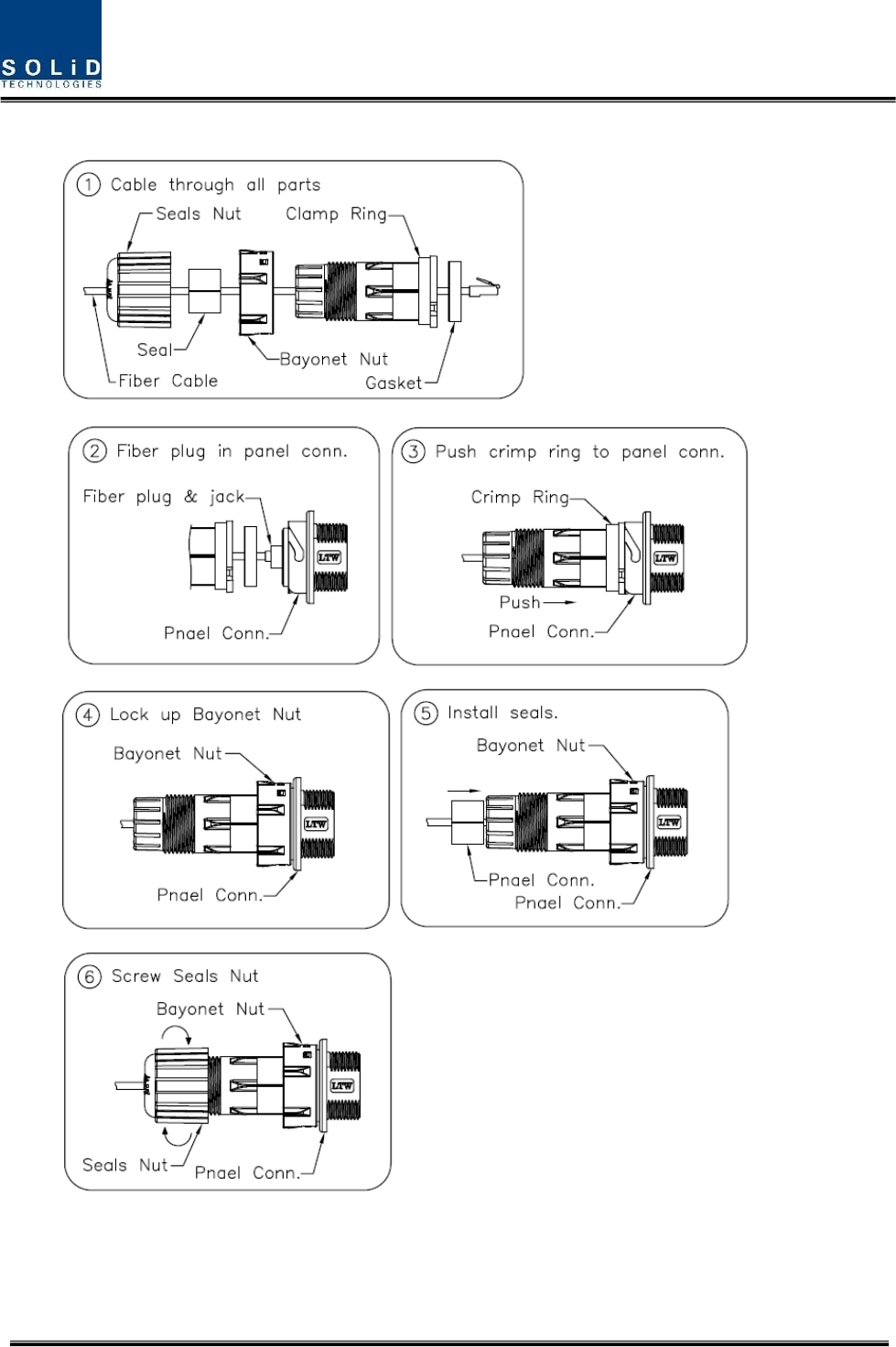
Confidential & Proprietary 37/43
Figure 20. How to install Optical Cabling
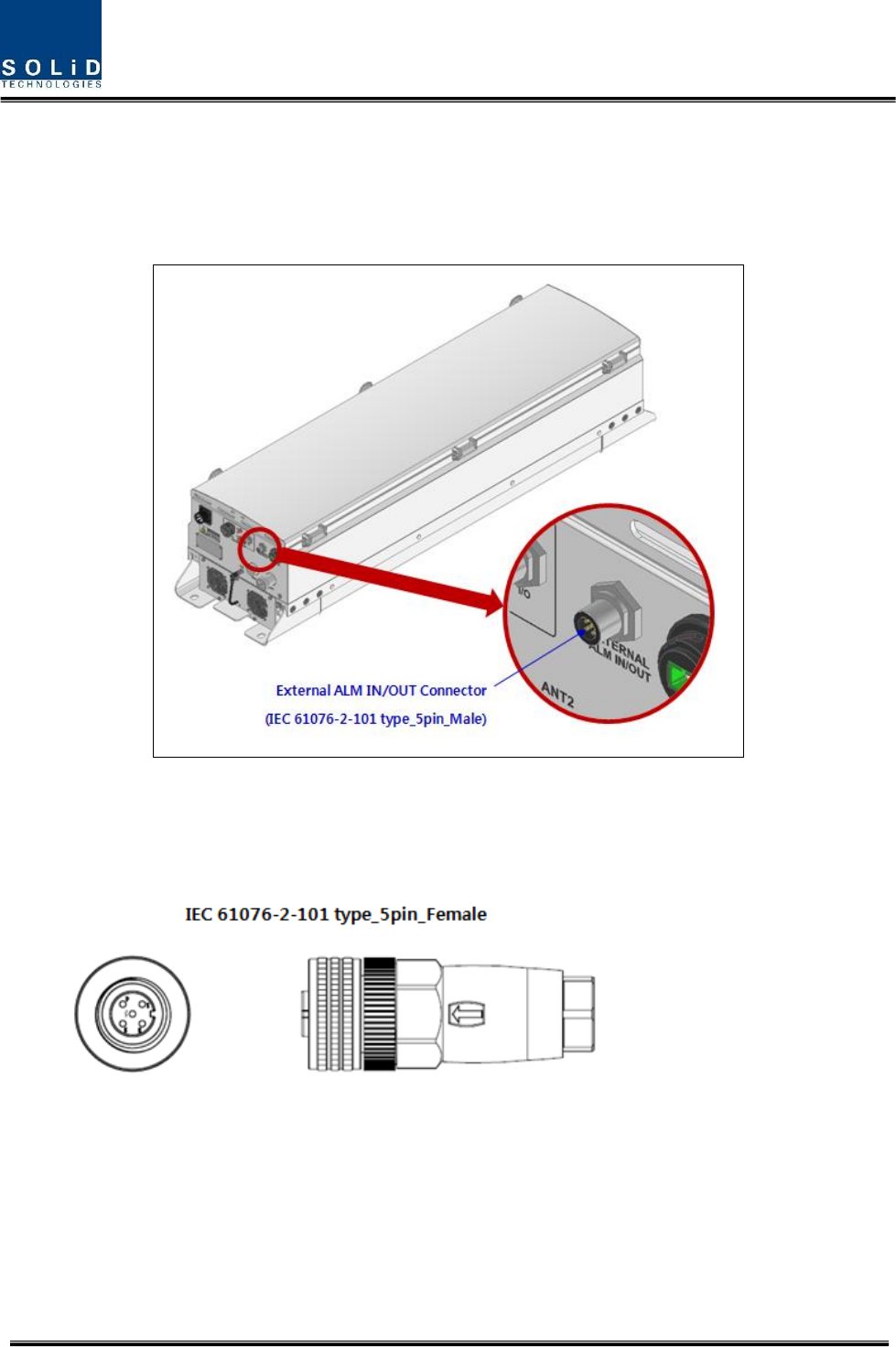
Confidential & Proprietary 38/43
4.1.8 HROU ALM IN/OUT Port cabling
The ALM IN/OUT Connector is located at the bottom of Remote Unit enclosure fixed. Cable can
be connected by using connectors.
Figure 21. Location of ALM IN/OUT Connector
The specification of compression ALM IN/OUT Connector is like below
Figure 22. Information of ALM IN/OUT Connector
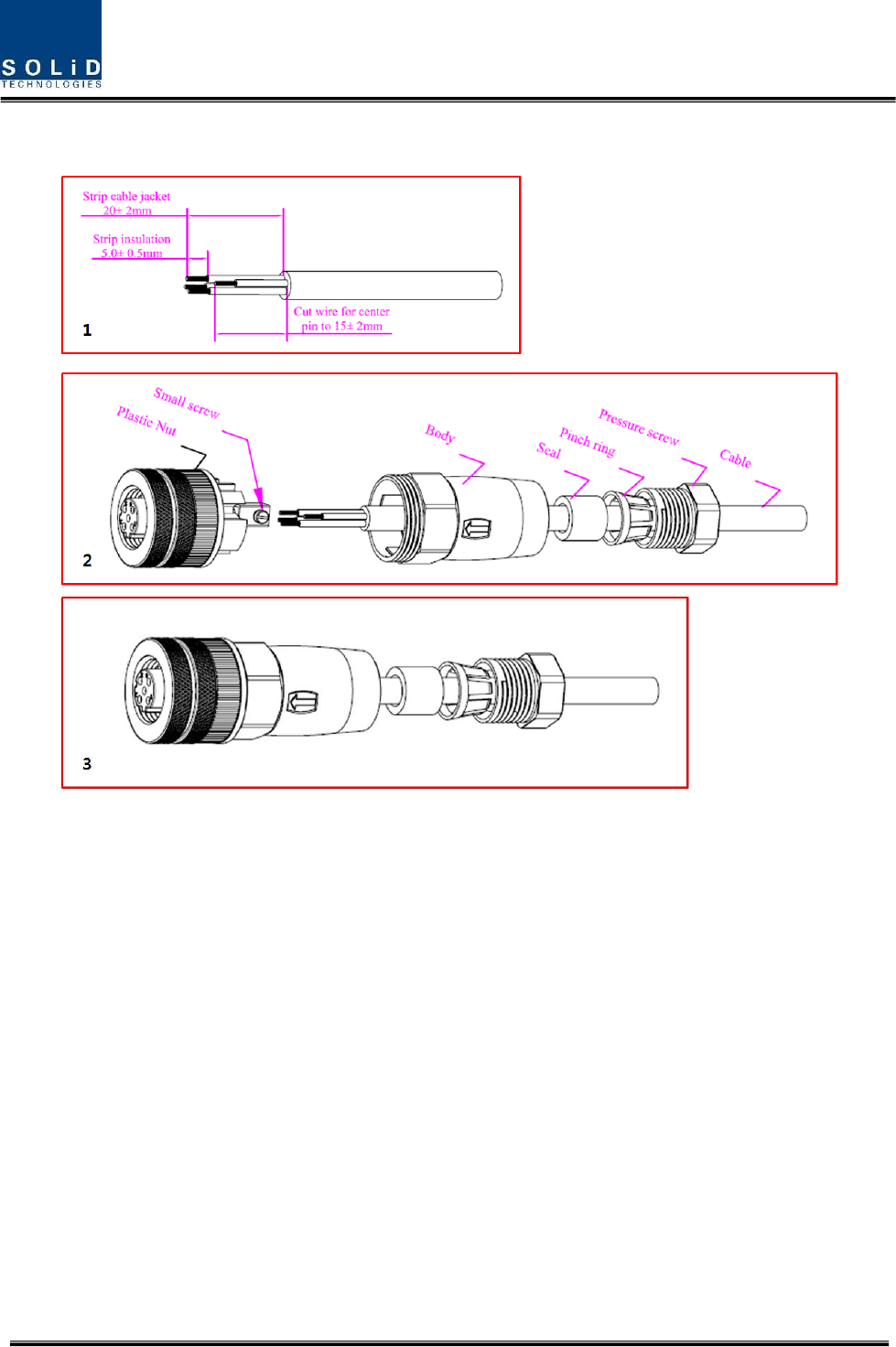
Confidential & Proprietary 39/43
The way to install the ALM IN/OUT Connector comply with below procedures
Figure 23. How to install ALM IN/OUT Cabling
The procedures are
Peel off sheath of the cable.
Assemble all components on cable as following.
Connect all wires to insert according to wire list, then tighten all small screws.
The torque for small screws is 0.2Nm.
Assemble plastic nut to main body. Recommended torque : 1.0Nm.
(Note : The key inside the main body must go straight to slot of insert.)
Push the cable seal, pinch ring into the main body, then tighten the pressure screw into the body with
recommended torque : 1.0Nm.
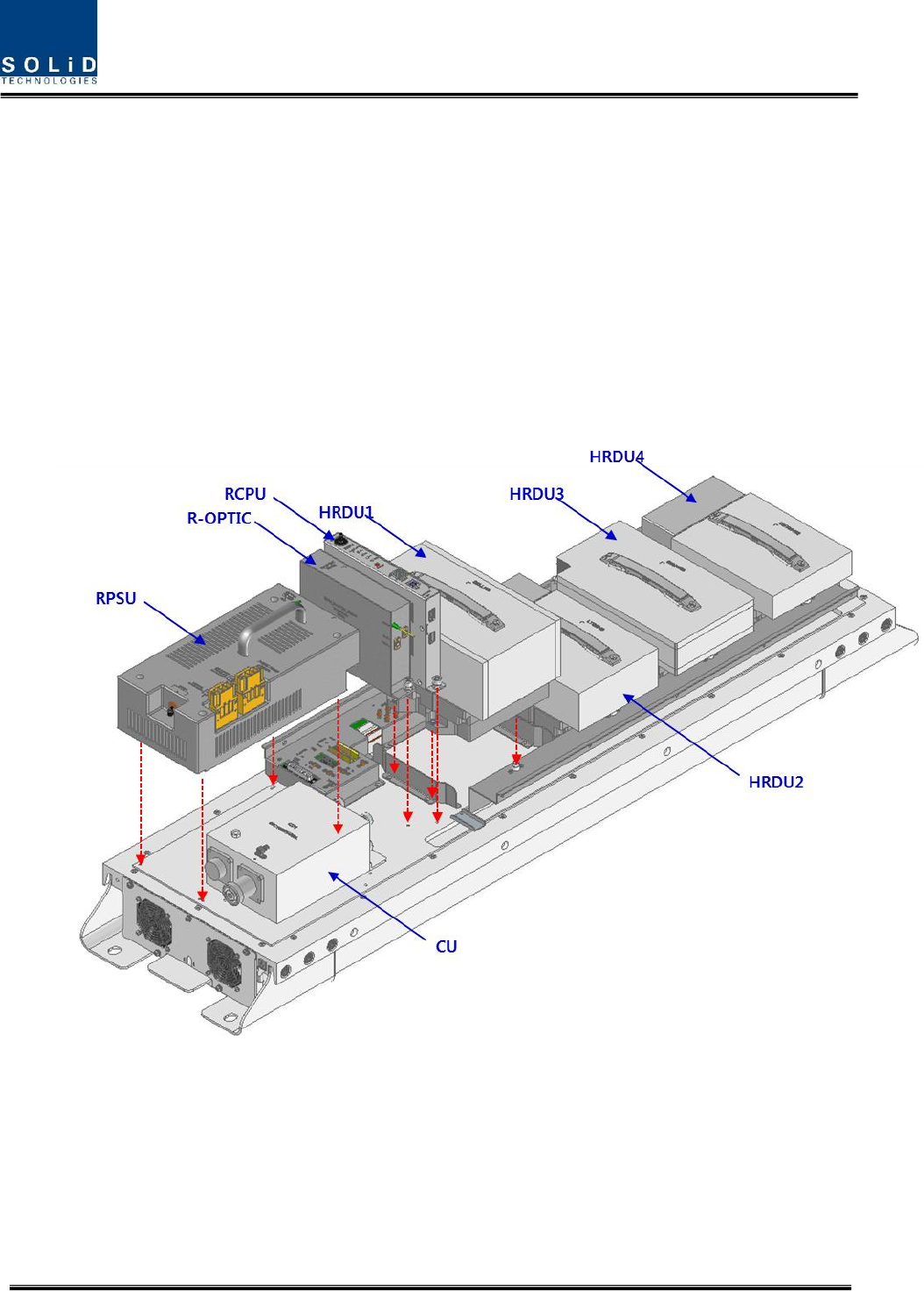
Confidential & Proprietary 40/43
4.1.9 Mounting of HRDU
HROU has slots to enable up to four HRDU modules to be mounted in it.
You can mount a HRDU into designated slot surely. It is not possible to provide services with a
HRDU module alone; you need to connect HRDU cavity duplexer antenna port with CU’s
designated port.
Figure 24. How to mount HRDU
The Remote Unit holds a maximum of 4 HRDUs. Guide brackets on the bottom of each HRDU slot
simplify installation as described below. MRDU installation requires a +No.1 tip size screwdriver.
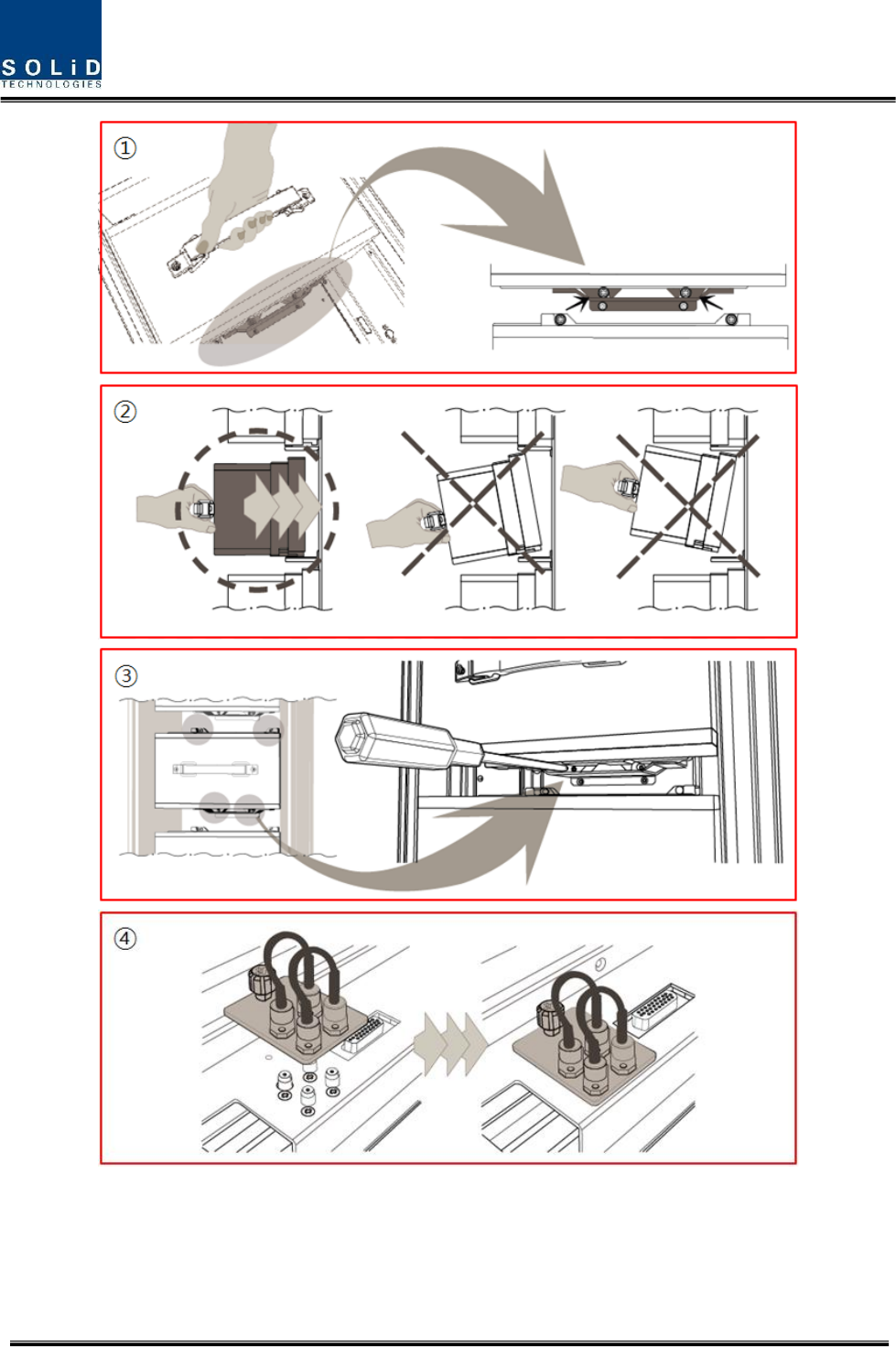
Confidential & Proprietary 41/43
Figure 25. How to mount HRDU

Confidential & Proprietary 42/43
The procedures are
1. Lift the HRDU onto the guide bracket and ensure the MRDU is level left to right
2. Push the HRDU into the corresponding slot in the direction of the heat sink while levelling the
MRDU to guide bracket
3. Make sure the HRDU is firmly inserted into the corresponding slot. Tighten the 4 corner screws
to secure the unit
4. Install HRDU blank cards in all unused slots in the remote. First insert the blank card into the
corresponding slot, then tighten the captive screw to secure it
"The Manufacturer's rated output power of this equipment is for single carrier operation. For
situations when multiple carrier signals are present, the rating would have to be reduced by 3.5
dB, especially where the output signal is re-radiated and can cause interference to adjacent
band users. This power reduction is to be by means of input power or gain reduction and not
by an attenuator at the output of the device."
RSS-GEN, Sec. 7.1.2 – (transmitters)
Under Industry Canada regulations, this radio transmitter may only operate using an antenna
of a type and maximum (or lesser) gain approved for the transmitter by Industry Canada. To
reduce potential radio interference to other users, the antenna type and its gain should be so
chosen that the equivalent isotropically radiated power (e.i.r.p.) is not more than that
necessary for successful communication.
Conformément à la réglementation d’Industrie Canada, le présent émetteur radio peut
fonctionneravec une antenne d’un type et d’un gain maximal (ou inférieur) approuvé pour
l’émetteur par Industrie Canada. Dans le but de réduire les risques de brouillage radioélectrique
à l’intention desautres utilisateurs, il faut choisir le type d’antenne et son gain de sorte que la
puissance isotroperayonnée quivalente (p.i.r.e.) ne dépassepas l’intensité nécessaire à
l’établissement d’une communication satisfaisante.

Confidential & Proprietary 43/43
RSS-GEN, Sec. 7.1.2 – (detachable antennas)
This radio transmitter (identify the device by certification number, or model number if
Category II)has been approved by Industry Canada to operate with the antenna types listed
below with the maximum permissible gain and required antenna impedance for each antenna
type indicated. Antenna types not included in this list, having a gain greater than the maximum
gain indicated for that type, are strictly prohibited for use with this device.
Le présent émetteur radio (identifier le dispositif par son numéro de certification ou son
numéro de modèle s’il fait partie du matériel de catégorie I) a été approuvé par Industrie
Canada pour fonctionner avec les types d’antenne énumérés ci-dessous et ayant un gain
admissible maximal et l’impédance requise pour chaque type d’antenne. Les types d’antenne
non inclus dans cette liste,ou dont le gain est supérieur au gain maximal indiqué, sont
strictement interdits pour l’exploitation de l’émetteur.
RF Radiation Exposure
This equipment complies with RF radiation exposure limits set forth for an uncontrolled
environment. This equipment should be installed and operated with a minimum distance of
500 cm between the radiator and your body. This transmitter must not be co-located or
operating in conjunction with any other antenna or transmitter. RF exposure will be addressed
at time of installation and the use of higher gain antennas may require larger separation
distances.
RSS-102 RF Exposure
L’antenne (ou les antennes) doit être installée de façon à maintenir à tout instant une distance
minimum de au moins 500 cm entre la source de radiation (l’antenne) et toute personne
physique. Cet appareil ne doit pas être installé ou utilisé en conjonction avec une autre antenne
ou émetteur.
